TASK - I Strategic Direction Growth Hacking Strategy Patanjali
VerifiedAdded on 2021/08/06
|22
|5200
|270
AI Summary
2 2 5 7 TASK - III 3 Vision & Mission 10 Strategic Drift 10 Business Model Canvas 10 TASK - IV 4 5 6 1 Market Development Strategy 14 Focused Differentiation Strategy 15 TASK - V Final Conclusion 18 References 20 TASK – 1 Founded in 2006, Patanjali Ayurved Limited (hereafter referred to as Patanjali) has grown spectacularly with an annual turnover touching nearly 1.16 bn, in the fiscal year 2016-17, the success is attributed to combined factors like low costs,
Contribute Materials
Your contribution can guide someone’s learning journey. Share your
documents today.
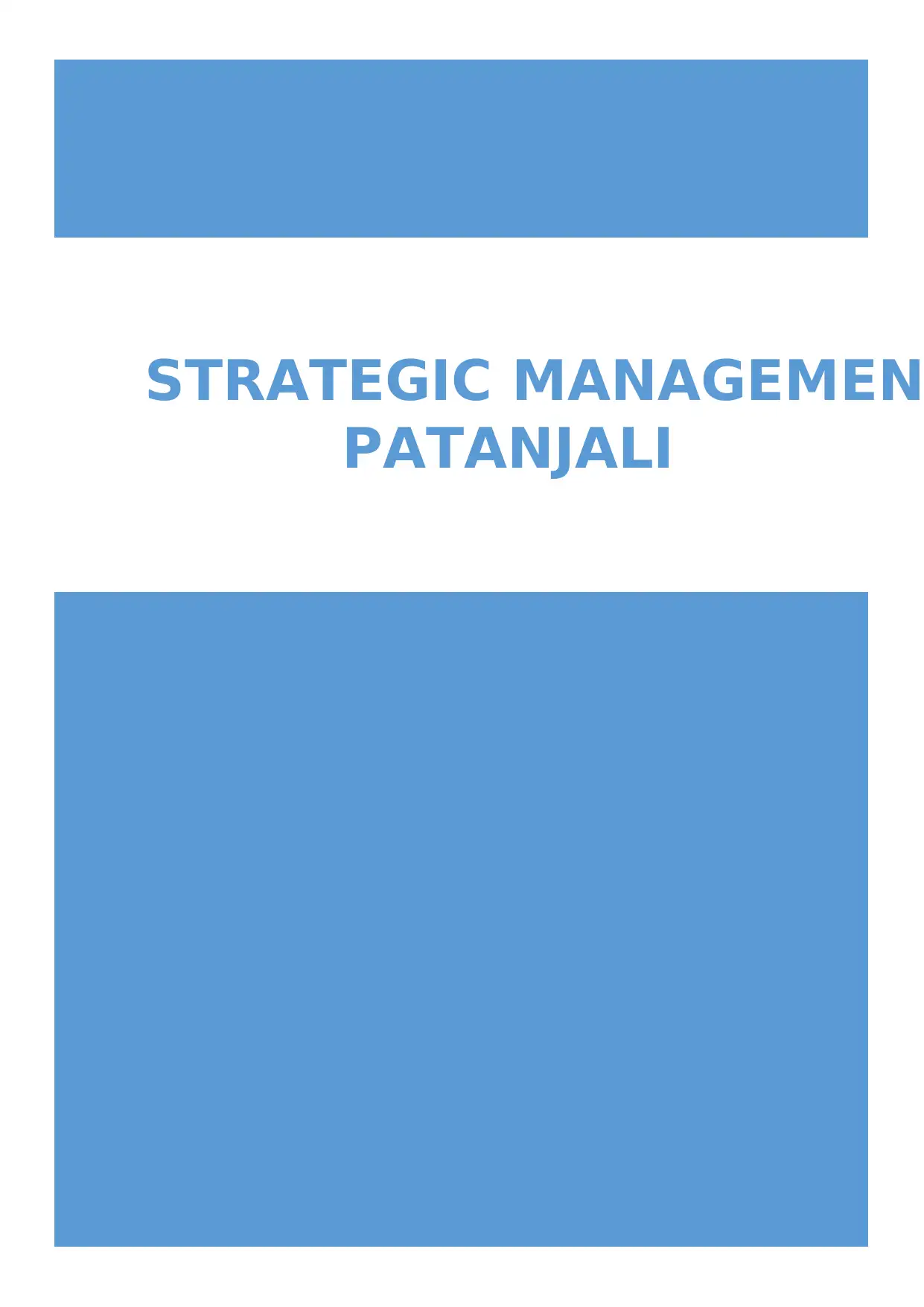
STRATEGIC MANAGEMEN
PATANJALI
PATANJALI
Secure Best Marks with AI Grader
Need help grading? Try our AI Grader for instant feedback on your assignments.
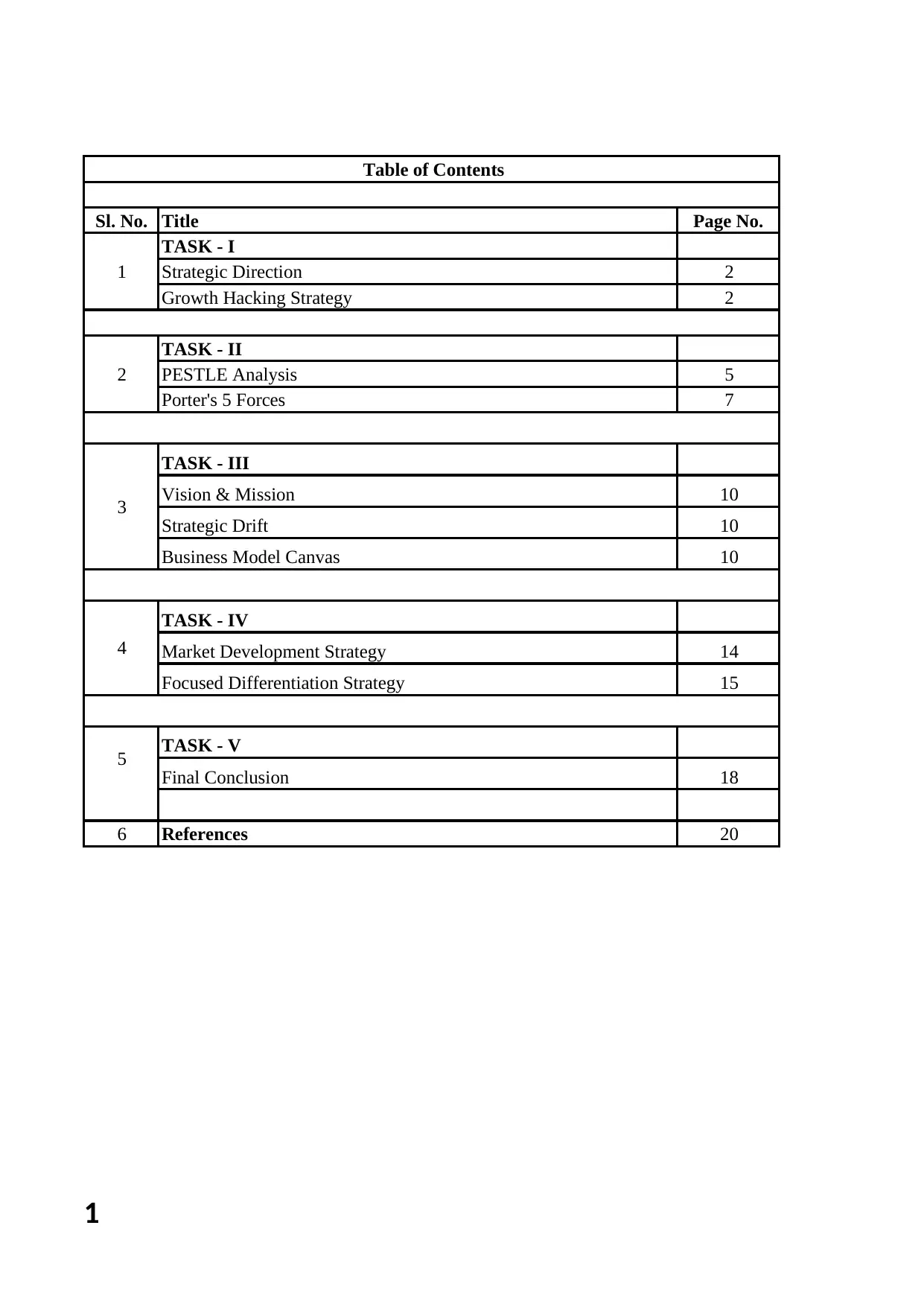
1
Sl. No. Page No.
TASK - I
2
2
TASK - II
5
7
TASK - III
10
10
10
TASK - IV
14
15
TASK - V
18
6 References 20
2
3
Table of Contents
Title
1 Strategic Direction
Growth Hacking Strategy
Market Development Strategy4
5
Focused Differentiation Strategy
Final Conclusion
PESTLE Analysis
Porter's 5 Forces
Vision & Mission
Strategic Drift
Business Model Canvas
Sl. No. Page No.
TASK - I
2
2
TASK - II
5
7
TASK - III
10
10
10
TASK - IV
14
15
TASK - V
18
6 References 20
2
3
Table of Contents
Title
1 Strategic Direction
Growth Hacking Strategy
Market Development Strategy4
5
Focused Differentiation Strategy
Final Conclusion
PESTLE Analysis
Porter's 5 Forces
Vision & Mission
Strategic Drift
Business Model Canvas

2
TASK – 1
Founded in 2006, Patanjali Ayurved Limited (hereafter referred to as Patanjali) has grown
spectacularly with an annual turnover touching nearly €1.16 bn, in the fiscal year 2016-17, the
success is attributed to combined factors like low costs, being a local brand thereby appealing to
people on a grass root level & having an exceptional distribution system, eventually disrupting
the Indian FMCG market (Gupta, et al., 2016).
The vision of Patanjali has always been focus on Nationalism, Ayurved & Yog as pillars, while
promoting a society that is healthier, by introducing the benefits of nature, while the mission is to
advance Ayurveda (Patanjali, 2020).
The strategy followed by Patanjali is “Growth Hacking Strategy”, this strategy is based on
experiments, and combinations to see what works best for the organization, and the prime goal of
this strategy, is to obtain multitude consumers, without spending a lot, therefore it is a
combination of cost effective strategies (Optinmonster, 2020).
Figure 1: Growth Hacking Strategy (Gasteren, 2020).
The strategy is a “combination of marketing, data & technology” (Gasteren, 2020).
The strategy is taken forward by the “Growth Hacker”, for Patanjali, the growth hacker is
“Swami Ramdev” himself, who is the founder & biggest brand ambassador himself (Khinda,
2017).
TASK – 1
Founded in 2006, Patanjali Ayurved Limited (hereafter referred to as Patanjali) has grown
spectacularly with an annual turnover touching nearly €1.16 bn, in the fiscal year 2016-17, the
success is attributed to combined factors like low costs, being a local brand thereby appealing to
people on a grass root level & having an exceptional distribution system, eventually disrupting
the Indian FMCG market (Gupta, et al., 2016).
The vision of Patanjali has always been focus on Nationalism, Ayurved & Yog as pillars, while
promoting a society that is healthier, by introducing the benefits of nature, while the mission is to
advance Ayurveda (Patanjali, 2020).
The strategy followed by Patanjali is “Growth Hacking Strategy”, this strategy is based on
experiments, and combinations to see what works best for the organization, and the prime goal of
this strategy, is to obtain multitude consumers, without spending a lot, therefore it is a
combination of cost effective strategies (Optinmonster, 2020).
Figure 1: Growth Hacking Strategy (Gasteren, 2020).
The strategy is a “combination of marketing, data & technology” (Gasteren, 2020).
The strategy is taken forward by the “Growth Hacker”, for Patanjali, the growth hacker is
“Swami Ramdev” himself, who is the founder & biggest brand ambassador himself (Khinda,
2017).
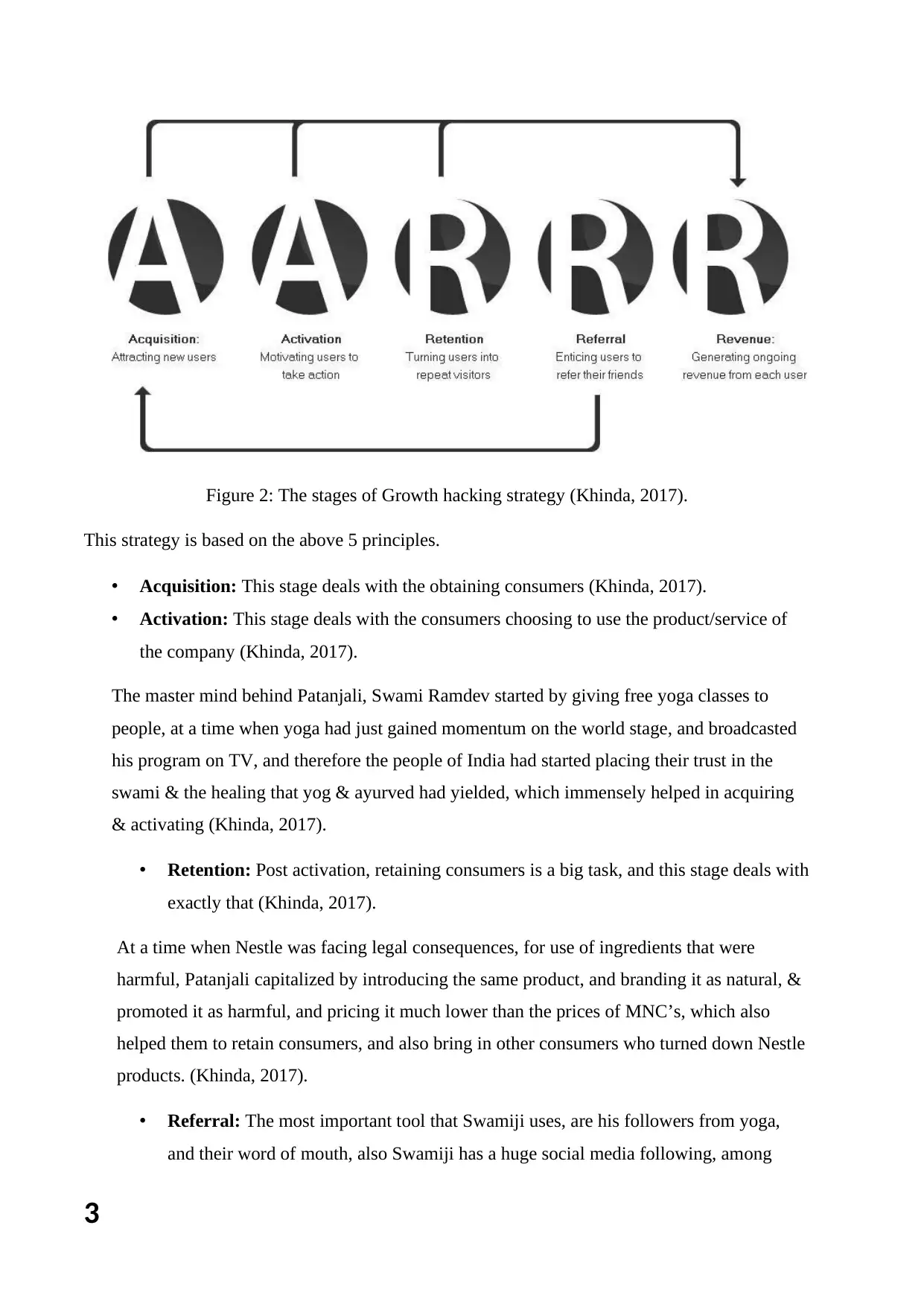
3
Figure 2: The stages of Growth hacking strategy (Khinda, 2017).
This strategy is based on the above 5 principles.
• Acquisition: This stage deals with the obtaining consumers (Khinda, 2017).
• Activation: This stage deals with the consumers choosing to use the product/service of
the company (Khinda, 2017).
The master mind behind Patanjali, Swami Ramdev started by giving free yoga classes to
people, at a time when yoga had just gained momentum on the world stage, and broadcasted
his program on TV, and therefore the people of India had started placing their trust in the
swami & the healing that yog & ayurved had yielded, which immensely helped in acquiring
& activating (Khinda, 2017).
• Retention: Post activation, retaining consumers is a big task, and this stage deals with
exactly that (Khinda, 2017).
At a time when Nestle was facing legal consequences, for use of ingredients that were
harmful, Patanjali capitalized by introducing the same product, and branding it as natural, &
promoted it as harmful, and pricing it much lower than the prices of MNC’s, which also
helped them to retain consumers, and also bring in other consumers who turned down Nestle
products. (Khinda, 2017).
• Referral: The most important tool that Swamiji uses, are his followers from yoga,
and their word of mouth, also Swamiji has a huge social media following, among
Figure 2: The stages of Growth hacking strategy (Khinda, 2017).
This strategy is based on the above 5 principles.
• Acquisition: This stage deals with the obtaining consumers (Khinda, 2017).
• Activation: This stage deals with the consumers choosing to use the product/service of
the company (Khinda, 2017).
The master mind behind Patanjali, Swami Ramdev started by giving free yoga classes to
people, at a time when yoga had just gained momentum on the world stage, and broadcasted
his program on TV, and therefore the people of India had started placing their trust in the
swami & the healing that yog & ayurved had yielded, which immensely helped in acquiring
& activating (Khinda, 2017).
• Retention: Post activation, retaining consumers is a big task, and this stage deals with
exactly that (Khinda, 2017).
At a time when Nestle was facing legal consequences, for use of ingredients that were
harmful, Patanjali capitalized by introducing the same product, and branding it as natural, &
promoted it as harmful, and pricing it much lower than the prices of MNC’s, which also
helped them to retain consumers, and also bring in other consumers who turned down Nestle
products. (Khinda, 2017).
• Referral: The most important tool that Swamiji uses, are his followers from yoga,
and their word of mouth, also Swamiji has a huge social media following, among
Secure Best Marks with AI Grader
Need help grading? Try our AI Grader for instant feedback on your assignments.
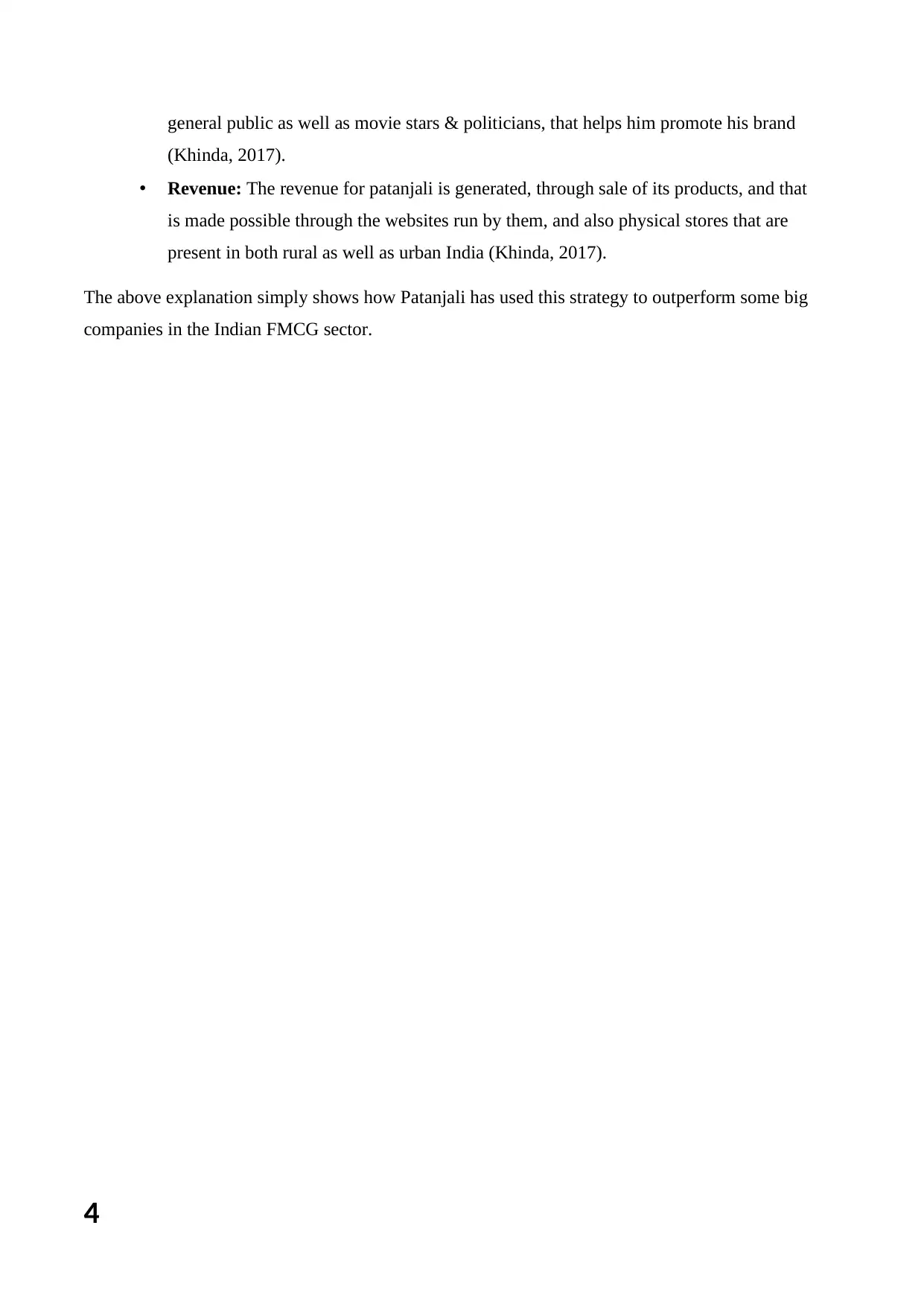
4
general public as well as movie stars & politicians, that helps him promote his brand
(Khinda, 2017).
• Revenue: The revenue for patanjali is generated, through sale of its products, and that
is made possible through the websites run by them, and also physical stores that are
present in both rural as well as urban India (Khinda, 2017).
The above explanation simply shows how Patanjali has used this strategy to outperform some big
companies in the Indian FMCG sector.
general public as well as movie stars & politicians, that helps him promote his brand
(Khinda, 2017).
• Revenue: The revenue for patanjali is generated, through sale of its products, and that
is made possible through the websites run by them, and also physical stores that are
present in both rural as well as urban India (Khinda, 2017).
The above explanation simply shows how Patanjali has used this strategy to outperform some big
companies in the Indian FMCG sector.
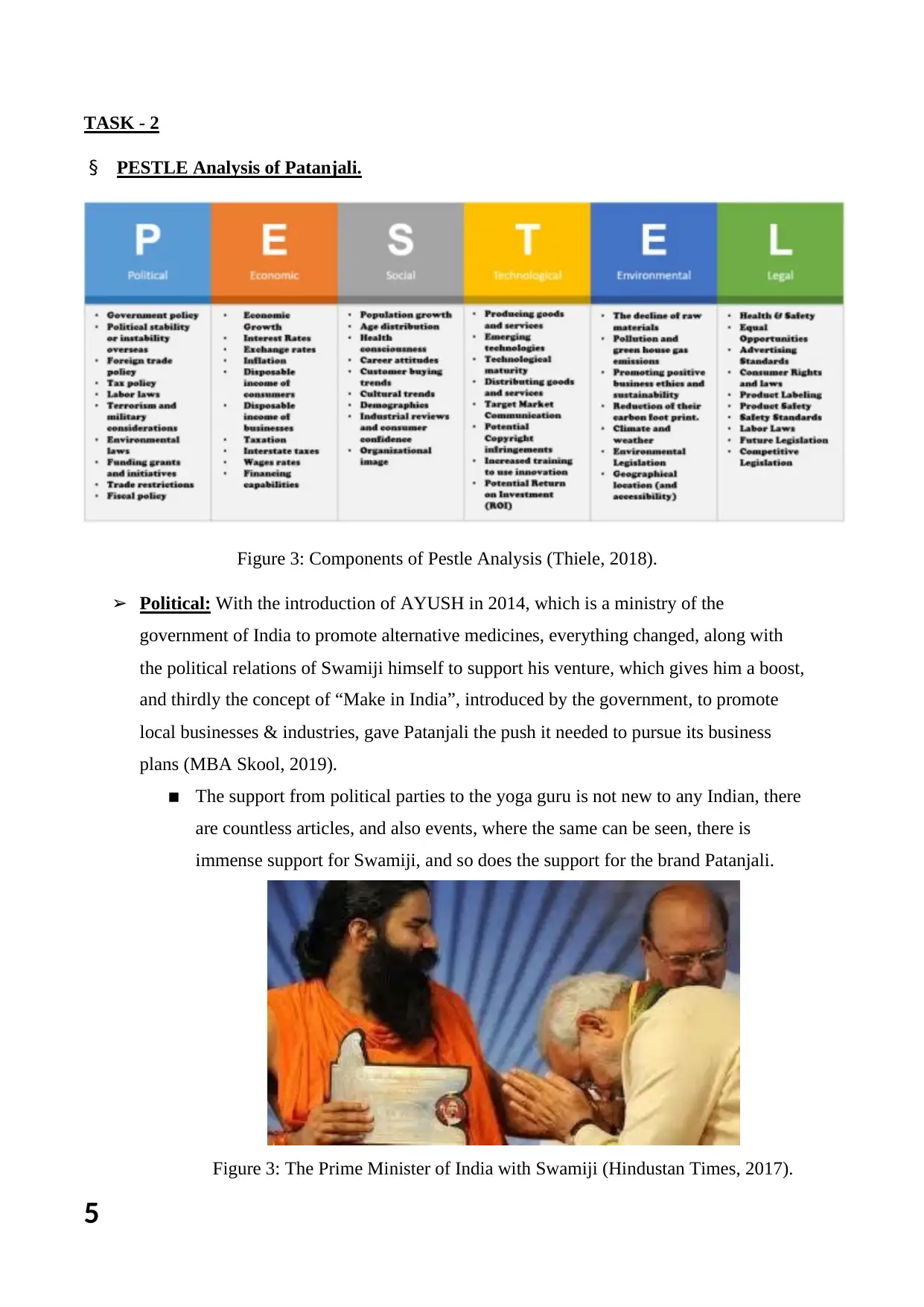
5
TASK - 2
§ PESTLE Analysis of Patanjali.
Figure 3: Components of Pestle Analysis (Thiele, 2018).
➢ Political: With the introduction of AYUSH in 2014, which is a ministry of the
government of India to promote alternative medicines, everything changed, along with
the political relations of Swamiji himself to support his venture, which gives him a boost,
and thirdly the concept of “Make in India”, introduced by the government, to promote
local businesses & industries, gave Patanjali the push it needed to pursue its business
plans (MBA Skool, 2019).
▪ The support from political parties to the yoga guru is not new to any Indian, there
are countless articles, and also events, where the same can be seen, there is
immense support for Swamiji, and so does the support for the brand Patanjali.
Figure 3: The Prime Minister of India with Swamiji (Hindustan Times, 2017).
TASK - 2
§ PESTLE Analysis of Patanjali.
Figure 3: Components of Pestle Analysis (Thiele, 2018).
➢ Political: With the introduction of AYUSH in 2014, which is a ministry of the
government of India to promote alternative medicines, everything changed, along with
the political relations of Swamiji himself to support his venture, which gives him a boost,
and thirdly the concept of “Make in India”, introduced by the government, to promote
local businesses & industries, gave Patanjali the push it needed to pursue its business
plans (MBA Skool, 2019).
▪ The support from political parties to the yoga guru is not new to any Indian, there
are countless articles, and also events, where the same can be seen, there is
immense support for Swamiji, and so does the support for the brand Patanjali.
Figure 3: The Prime Minister of India with Swamiji (Hindustan Times, 2017).
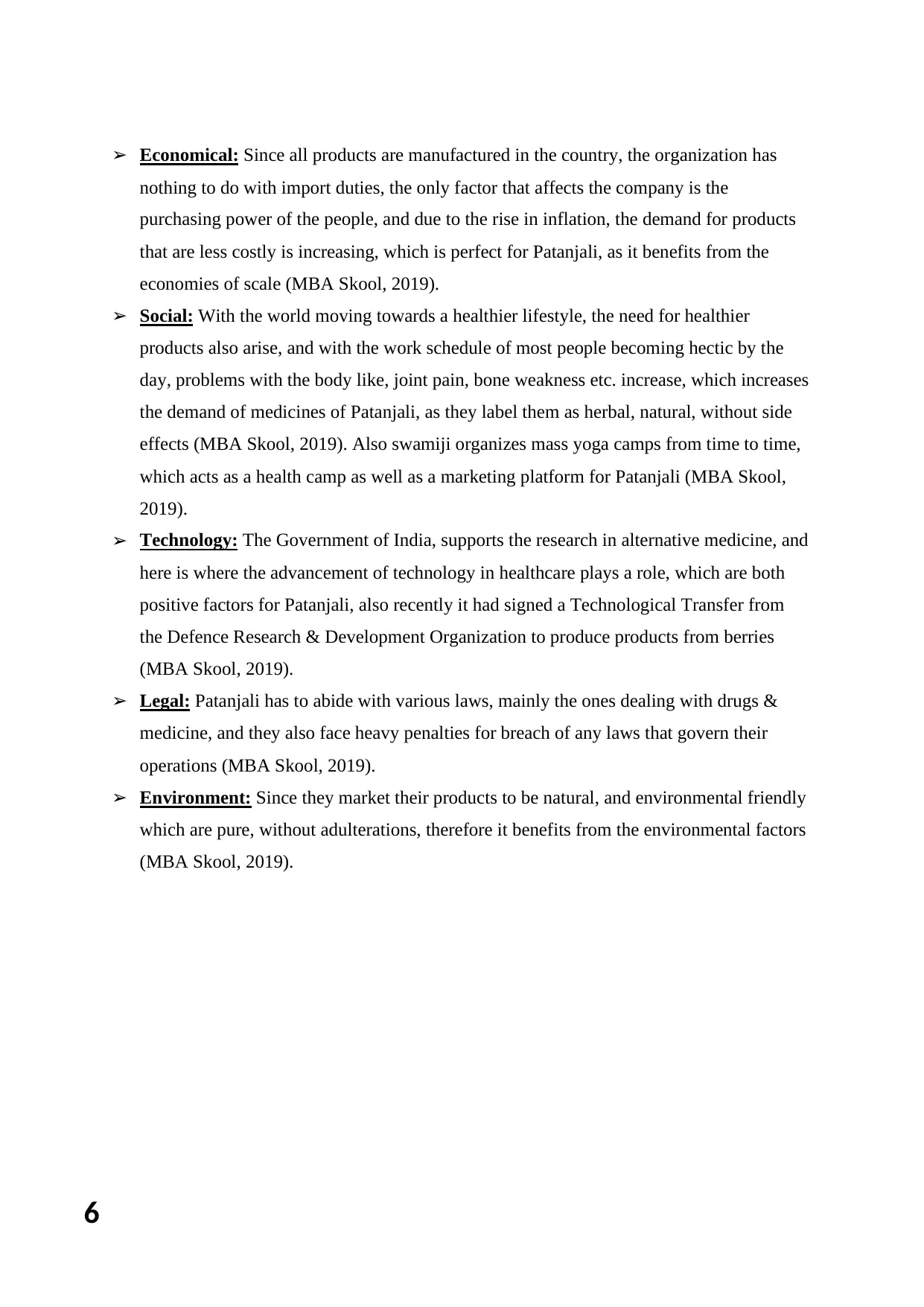
6
➢ Economical: Since all products are manufactured in the country, the organization has
nothing to do with import duties, the only factor that affects the company is the
purchasing power of the people, and due to the rise in inflation, the demand for products
that are less costly is increasing, which is perfect for Patanjali, as it benefits from the
economies of scale (MBA Skool, 2019).
➢ Social: With the world moving towards a healthier lifestyle, the need for healthier
products also arise, and with the work schedule of most people becoming hectic by the
day, problems with the body like, joint pain, bone weakness etc. increase, which increases
the demand of medicines of Patanjali, as they label them as herbal, natural, without side
effects (MBA Skool, 2019). Also swamiji organizes mass yoga camps from time to time,
which acts as a health camp as well as a marketing platform for Patanjali (MBA Skool,
2019).
➢ Technology: The Government of India, supports the research in alternative medicine, and
here is where the advancement of technology in healthcare plays a role, which are both
positive factors for Patanjali, also recently it had signed a Technological Transfer from
the Defence Research & Development Organization to produce products from berries
(MBA Skool, 2019).
➢ Legal: Patanjali has to abide with various laws, mainly the ones dealing with drugs &
medicine, and they also face heavy penalties for breach of any laws that govern their
operations (MBA Skool, 2019).
➢ Environment: Since they market their products to be natural, and environmental friendly
which are pure, without adulterations, therefore it benefits from the environmental factors
(MBA Skool, 2019).
➢ Economical: Since all products are manufactured in the country, the organization has
nothing to do with import duties, the only factor that affects the company is the
purchasing power of the people, and due to the rise in inflation, the demand for products
that are less costly is increasing, which is perfect for Patanjali, as it benefits from the
economies of scale (MBA Skool, 2019).
➢ Social: With the world moving towards a healthier lifestyle, the need for healthier
products also arise, and with the work schedule of most people becoming hectic by the
day, problems with the body like, joint pain, bone weakness etc. increase, which increases
the demand of medicines of Patanjali, as they label them as herbal, natural, without side
effects (MBA Skool, 2019). Also swamiji organizes mass yoga camps from time to time,
which acts as a health camp as well as a marketing platform for Patanjali (MBA Skool,
2019).
➢ Technology: The Government of India, supports the research in alternative medicine, and
here is where the advancement of technology in healthcare plays a role, which are both
positive factors for Patanjali, also recently it had signed a Technological Transfer from
the Defence Research & Development Organization to produce products from berries
(MBA Skool, 2019).
➢ Legal: Patanjali has to abide with various laws, mainly the ones dealing with drugs &
medicine, and they also face heavy penalties for breach of any laws that govern their
operations (MBA Skool, 2019).
➢ Environment: Since they market their products to be natural, and environmental friendly
which are pure, without adulterations, therefore it benefits from the environmental factors
(MBA Skool, 2019).
Paraphrase This Document
Need a fresh take? Get an instant paraphrase of this document with our AI Paraphraser
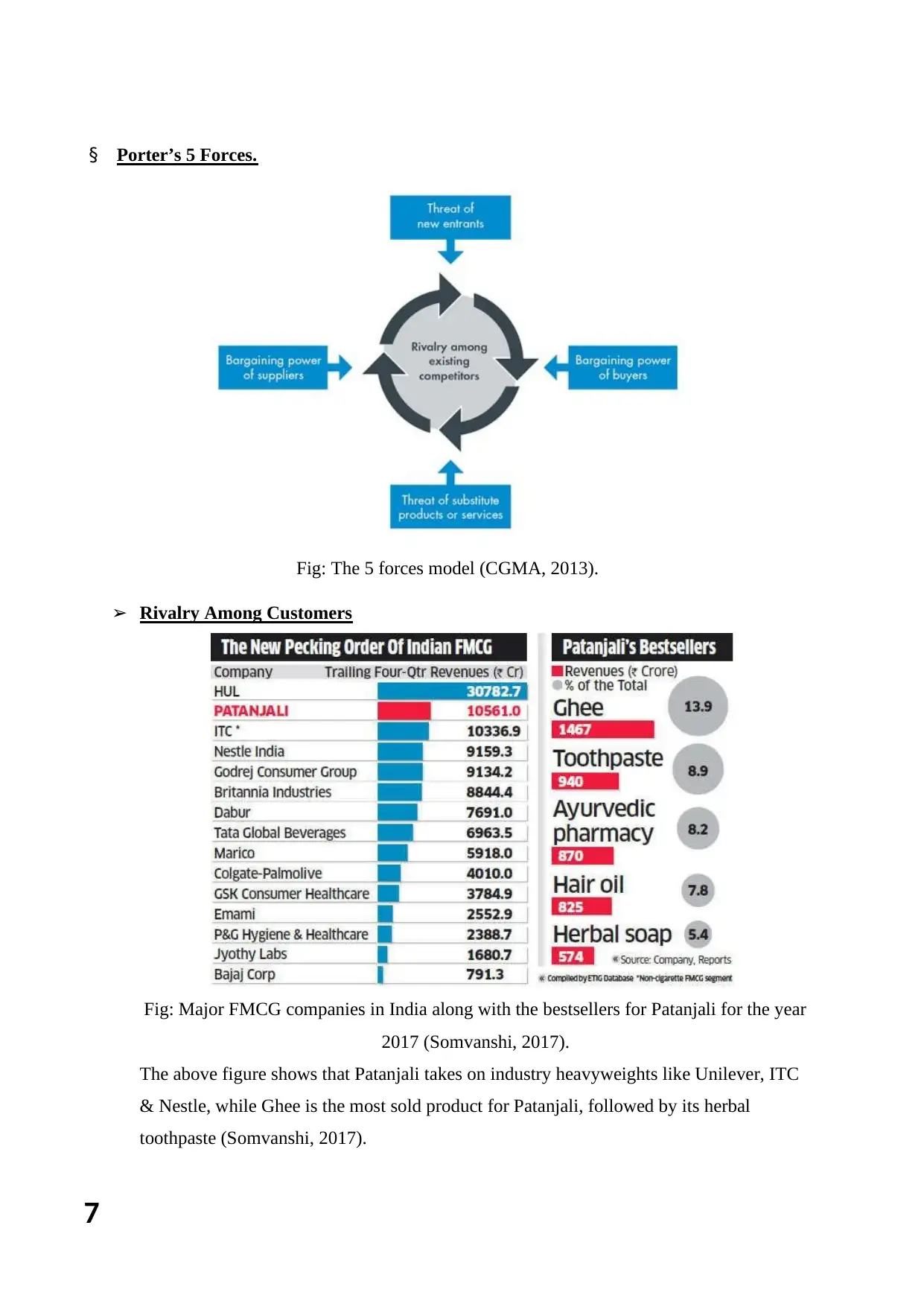
7
§ Porter’s 5 Forces.
Fig: The 5 forces model (CGMA, 2013).
➢ Rivalry Among Customers
Fig: Major FMCG companies in India along with the bestsellers for Patanjali for the year
2017 (Somvanshi, 2017).
The above figure shows that Patanjali takes on industry heavyweights like Unilever, ITC
& Nestle, while Ghee is the most sold product for Patanjali, followed by its herbal
toothpaste (Somvanshi, 2017).
§ Porter’s 5 Forces.
Fig: The 5 forces model (CGMA, 2013).
➢ Rivalry Among Customers
Fig: Major FMCG companies in India along with the bestsellers for Patanjali for the year
2017 (Somvanshi, 2017).
The above figure shows that Patanjali takes on industry heavyweights like Unilever, ITC
& Nestle, while Ghee is the most sold product for Patanjali, followed by its herbal
toothpaste (Somvanshi, 2017).
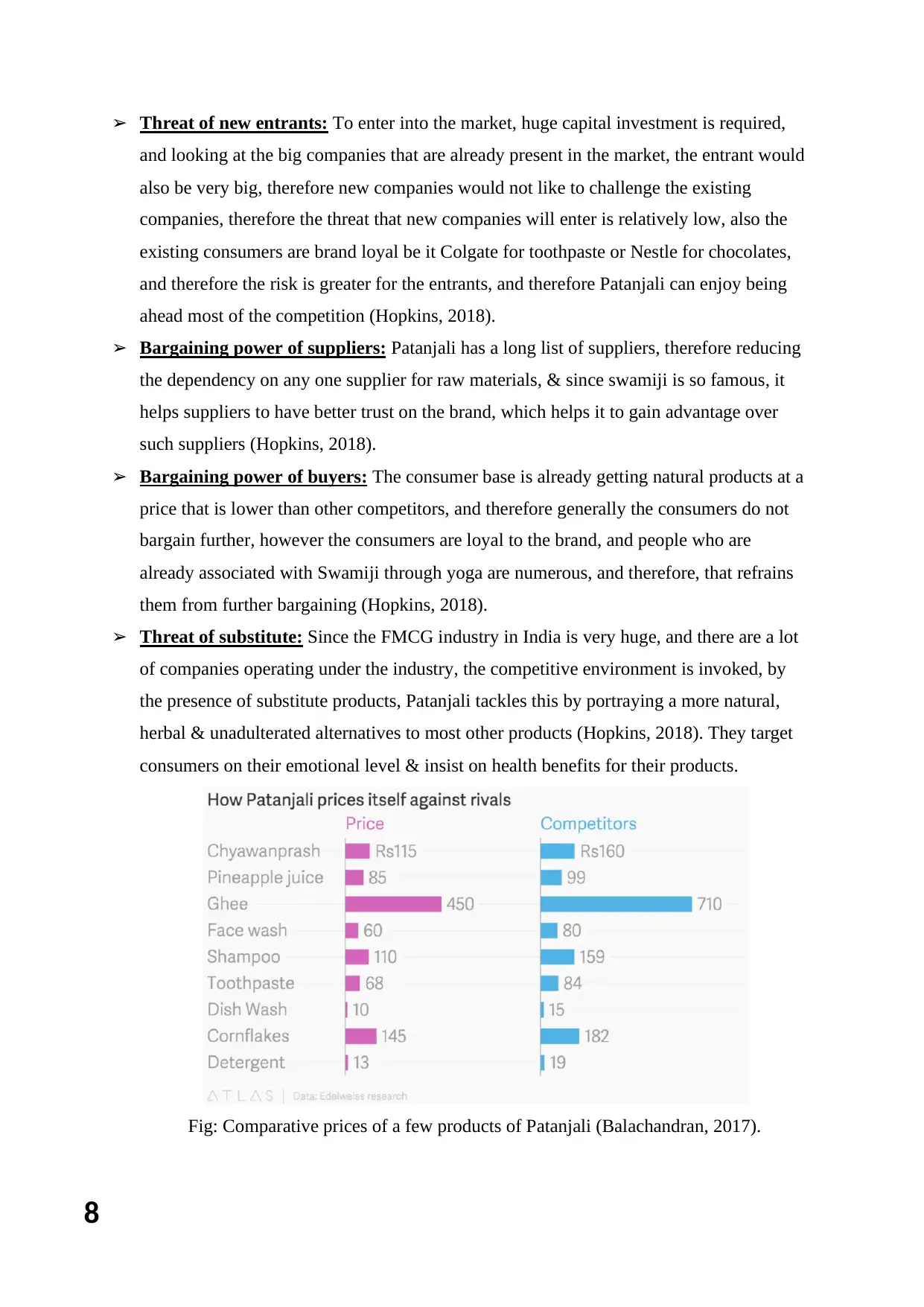
8
➢ Threat of new entrants: To enter into the market, huge capital investment is required,
and looking at the big companies that are already present in the market, the entrant would
also be very big, therefore new companies would not like to challenge the existing
companies, therefore the threat that new companies will enter is relatively low, also the
existing consumers are brand loyal be it Colgate for toothpaste or Nestle for chocolates,
and therefore the risk is greater for the entrants, and therefore Patanjali can enjoy being
ahead most of the competition (Hopkins, 2018).
➢ Bargaining power of suppliers: Patanjali has a long list of suppliers, therefore reducing
the dependency on any one supplier for raw materials, & since swamiji is so famous, it
helps suppliers to have better trust on the brand, which helps it to gain advantage over
such suppliers (Hopkins, 2018).
➢ Bargaining power of buyers: The consumer base is already getting natural products at a
price that is lower than other competitors, and therefore generally the consumers do not
bargain further, however the consumers are loyal to the brand, and people who are
already associated with Swamiji through yoga are numerous, and therefore, that refrains
them from further bargaining (Hopkins, 2018).
➢ Threat of substitute: Since the FMCG industry in India is very huge, and there are a lot
of companies operating under the industry, the competitive environment is invoked, by
the presence of substitute products, Patanjali tackles this by portraying a more natural,
herbal & unadulterated alternatives to most other products (Hopkins, 2018). They target
consumers on their emotional level & insist on health benefits for their products.
Fig: Comparative prices of a few products of Patanjali (Balachandran, 2017).
➢ Threat of new entrants: To enter into the market, huge capital investment is required,
and looking at the big companies that are already present in the market, the entrant would
also be very big, therefore new companies would not like to challenge the existing
companies, therefore the threat that new companies will enter is relatively low, also the
existing consumers are brand loyal be it Colgate for toothpaste or Nestle for chocolates,
and therefore the risk is greater for the entrants, and therefore Patanjali can enjoy being
ahead most of the competition (Hopkins, 2018).
➢ Bargaining power of suppliers: Patanjali has a long list of suppliers, therefore reducing
the dependency on any one supplier for raw materials, & since swamiji is so famous, it
helps suppliers to have better trust on the brand, which helps it to gain advantage over
such suppliers (Hopkins, 2018).
➢ Bargaining power of buyers: The consumer base is already getting natural products at a
price that is lower than other competitors, and therefore generally the consumers do not
bargain further, however the consumers are loyal to the brand, and people who are
already associated with Swamiji through yoga are numerous, and therefore, that refrains
them from further bargaining (Hopkins, 2018).
➢ Threat of substitute: Since the FMCG industry in India is very huge, and there are a lot
of companies operating under the industry, the competitive environment is invoked, by
the presence of substitute products, Patanjali tackles this by portraying a more natural,
herbal & unadulterated alternatives to most other products (Hopkins, 2018). They target
consumers on their emotional level & insist on health benefits for their products.
Fig: Comparative prices of a few products of Patanjali (Balachandran, 2017).

9
From the above figure we can conclude that most of the substitute products of Patanjali
are priced higher than those provided by Patanjali, & therefore Patanjali enjoys
competitor dominance in the industry.
From the above figure we can conclude that most of the substitute products of Patanjali
are priced higher than those provided by Patanjali, & therefore Patanjali enjoys
competitor dominance in the industry.
Secure Best Marks with AI Grader
Need help grading? Try our AI Grader for instant feedback on your assignments.
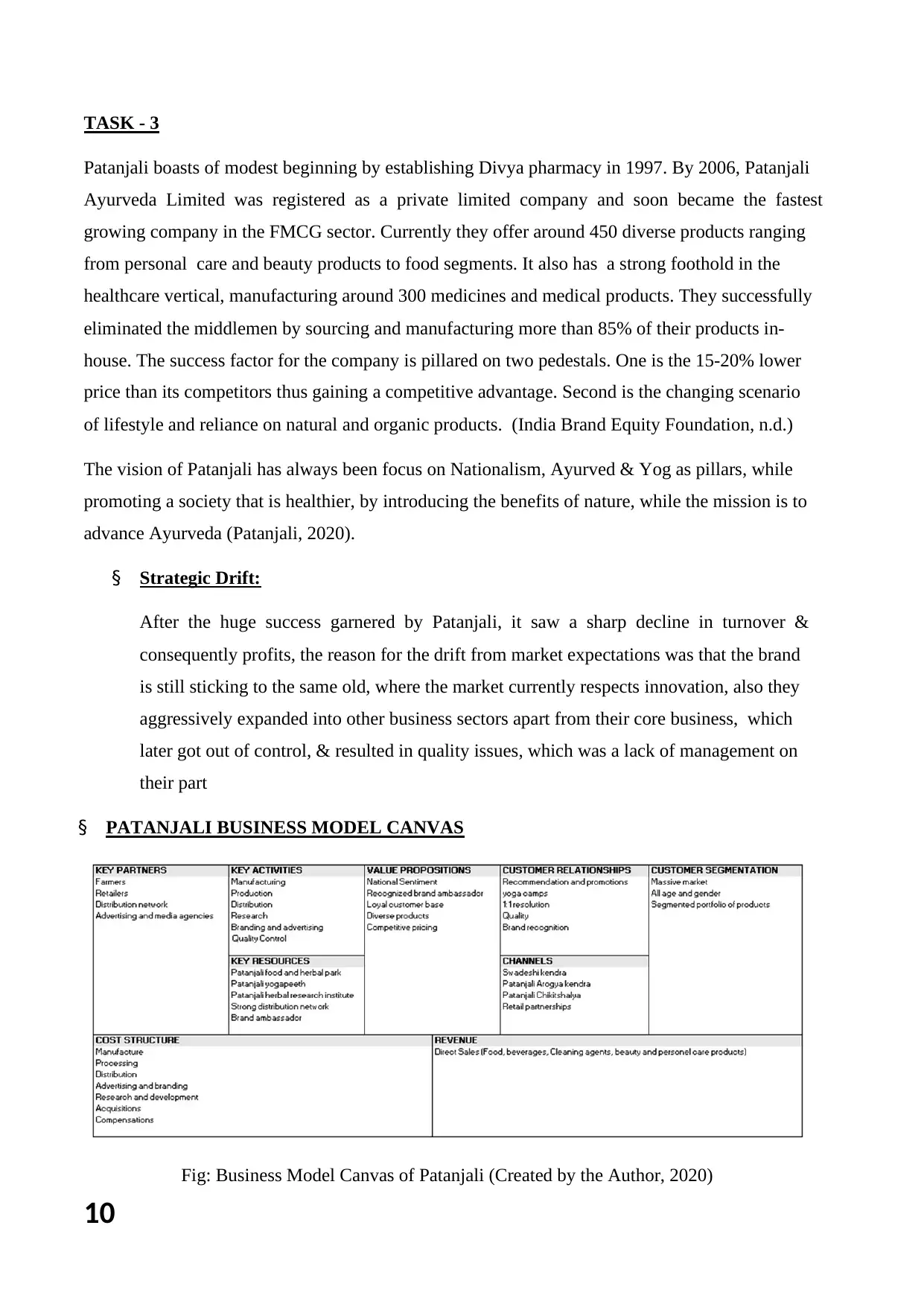
10
TASK - 3
Patanjali boasts of modest beginning by establishing Divya pharmacy in 1997. By 2006, Patanjali
Ayurveda Limited was registered as a private limited company and soon became the fastest
growing company in the FMCG sector. Currently they offer around 450 diverse products ranging
from personal care and beauty products to food segments. It also has a strong foothold in the
healthcare vertical, manufacturing around 300 medicines and medical products. They successfully
eliminated the middlemen by sourcing and manufacturing more than 85% of their products in-
house. The success factor for the company is pillared on two pedestals. One is the 15-20% lower
price than its competitors thus gaining a competitive advantage. Second is the changing scenario
of lifestyle and reliance on natural and organic products. (India Brand Equity Foundation, n.d.)
The vision of Patanjali has always been focus on Nationalism, Ayurved & Yog as pillars, while
promoting a society that is healthier, by introducing the benefits of nature, while the mission is to
advance Ayurveda (Patanjali, 2020).
§ Strategic Drift:
After the huge success garnered by Patanjali, it saw a sharp decline in turnover &
consequently profits, the reason for the drift from market expectations was that the brand
is still sticking to the same old, where the market currently respects innovation, also they
aggressively expanded into other business sectors apart from their core business, which
later got out of control, & resulted in quality issues, which was a lack of management on
their part
§ PATANJALI BUSINESS MODEL CANVAS
Fig: Business Model Canvas of Patanjali (Created by the Author, 2020)
TASK - 3
Patanjali boasts of modest beginning by establishing Divya pharmacy in 1997. By 2006, Patanjali
Ayurveda Limited was registered as a private limited company and soon became the fastest
growing company in the FMCG sector. Currently they offer around 450 diverse products ranging
from personal care and beauty products to food segments. It also has a strong foothold in the
healthcare vertical, manufacturing around 300 medicines and medical products. They successfully
eliminated the middlemen by sourcing and manufacturing more than 85% of their products in-
house. The success factor for the company is pillared on two pedestals. One is the 15-20% lower
price than its competitors thus gaining a competitive advantage. Second is the changing scenario
of lifestyle and reliance on natural and organic products. (India Brand Equity Foundation, n.d.)
The vision of Patanjali has always been focus on Nationalism, Ayurved & Yog as pillars, while
promoting a society that is healthier, by introducing the benefits of nature, while the mission is to
advance Ayurveda (Patanjali, 2020).
§ Strategic Drift:
After the huge success garnered by Patanjali, it saw a sharp decline in turnover &
consequently profits, the reason for the drift from market expectations was that the brand
is still sticking to the same old, where the market currently respects innovation, also they
aggressively expanded into other business sectors apart from their core business, which
later got out of control, & resulted in quality issues, which was a lack of management on
their part
§ PATANJALI BUSINESS MODEL CANVAS
Fig: Business Model Canvas of Patanjali (Created by the Author, 2020)
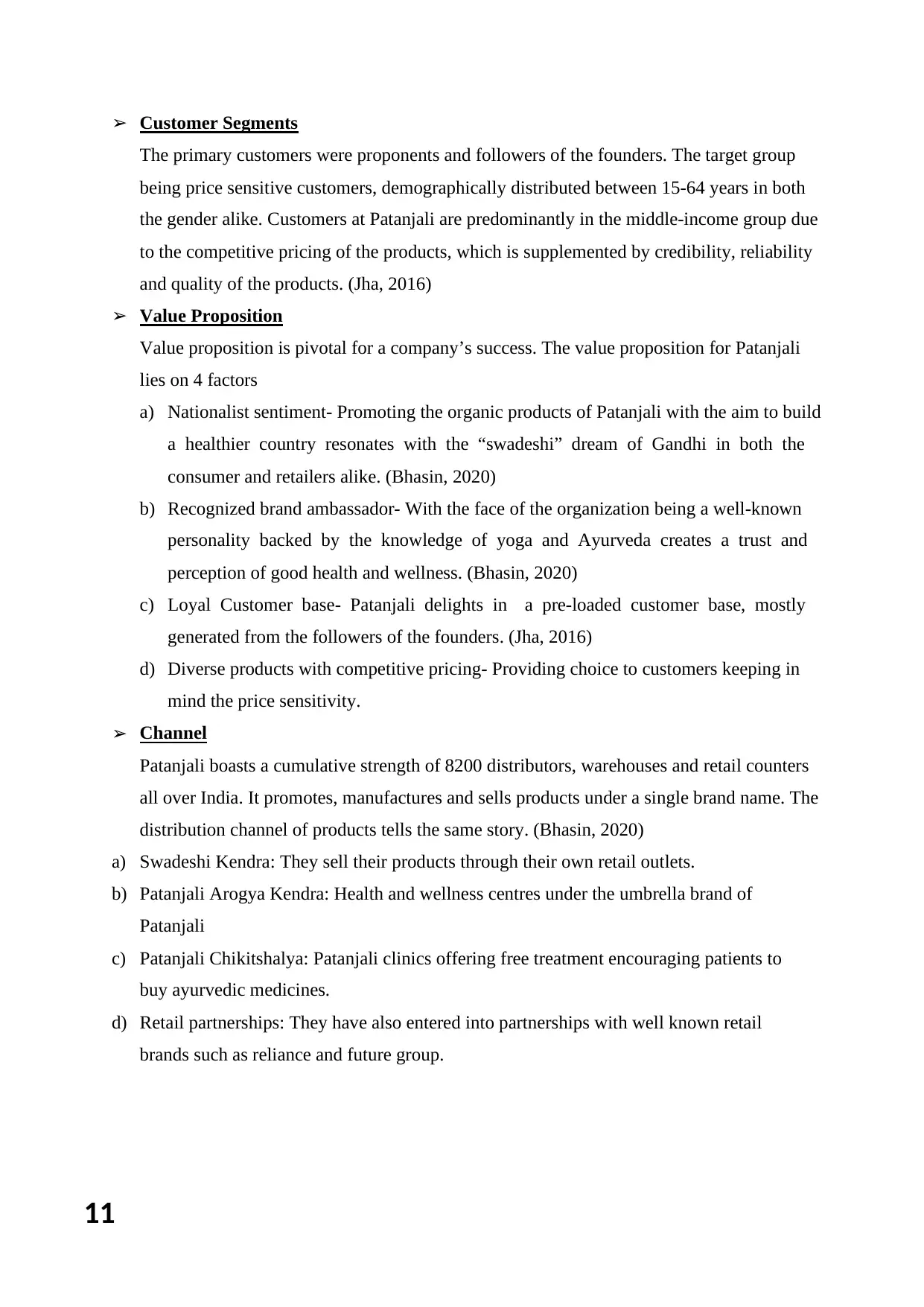
11
➢ Customer Segments
The primary customers were proponents and followers of the founders. The target group
being price sensitive customers, demographically distributed between 15-64 years in both
the gender alike. Customers at Patanjali are predominantly in the middle-income group due
to the competitive pricing of the products, which is supplemented by credibility, reliability
and quality of the products. (Jha, 2016)
➢ Value Proposition
Value proposition is pivotal for a company’s success. The value proposition for Patanjali
lies on 4 factors
a) Nationalist sentiment- Promoting the organic products of Patanjali with the aim to build
a healthier country resonates with the “swadeshi” dream of Gandhi in both the
consumer and retailers alike. (Bhasin, 2020)
b) Recognized brand ambassador- With the face of the organization being a well-known
personality backed by the knowledge of yoga and Ayurveda creates a trust and
perception of good health and wellness. (Bhasin, 2020)
c) Loyal Customer base- Patanjali delights in a pre-loaded customer base, mostly
generated from the followers of the founders. (Jha, 2016)
d) Diverse products with competitive pricing- Providing choice to customers keeping in
mind the price sensitivity.
➢ Channel
Patanjali boasts a cumulative strength of 8200 distributors, warehouses and retail counters
all over India. It promotes, manufactures and sells products under a single brand name. The
distribution channel of products tells the same story. (Bhasin, 2020)
a) Swadeshi Kendra: They sell their products through their own retail outlets.
b) Patanjali Arogya Kendra: Health and wellness centres under the umbrella brand of
Patanjali
c) Patanjali Chikitshalya: Patanjali clinics offering free treatment encouraging patients to
buy ayurvedic medicines.
d) Retail partnerships: They have also entered into partnerships with well known retail
brands such as reliance and future group.
➢ Customer Segments
The primary customers were proponents and followers of the founders. The target group
being price sensitive customers, demographically distributed between 15-64 years in both
the gender alike. Customers at Patanjali are predominantly in the middle-income group due
to the competitive pricing of the products, which is supplemented by credibility, reliability
and quality of the products. (Jha, 2016)
➢ Value Proposition
Value proposition is pivotal for a company’s success. The value proposition for Patanjali
lies on 4 factors
a) Nationalist sentiment- Promoting the organic products of Patanjali with the aim to build
a healthier country resonates with the “swadeshi” dream of Gandhi in both the
consumer and retailers alike. (Bhasin, 2020)
b) Recognized brand ambassador- With the face of the organization being a well-known
personality backed by the knowledge of yoga and Ayurveda creates a trust and
perception of good health and wellness. (Bhasin, 2020)
c) Loyal Customer base- Patanjali delights in a pre-loaded customer base, mostly
generated from the followers of the founders. (Jha, 2016)
d) Diverse products with competitive pricing- Providing choice to customers keeping in
mind the price sensitivity.
➢ Channel
Patanjali boasts a cumulative strength of 8200 distributors, warehouses and retail counters
all over India. It promotes, manufactures and sells products under a single brand name. The
distribution channel of products tells the same story. (Bhasin, 2020)
a) Swadeshi Kendra: They sell their products through their own retail outlets.
b) Patanjali Arogya Kendra: Health and wellness centres under the umbrella brand of
Patanjali
c) Patanjali Chikitshalya: Patanjali clinics offering free treatment encouraging patients to
buy ayurvedic medicines.
d) Retail partnerships: They have also entered into partnerships with well known retail
brands such as reliance and future group.
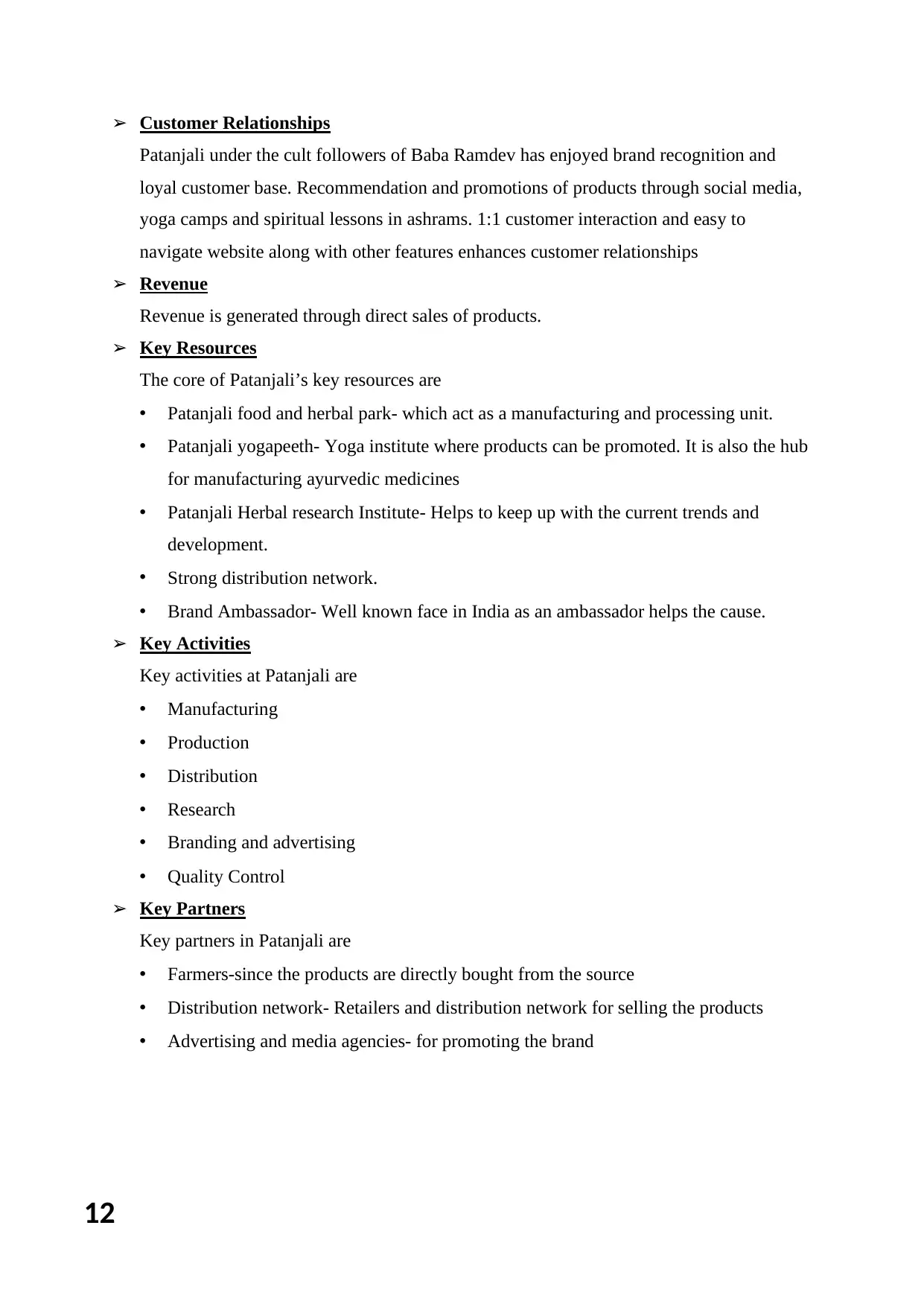
12
➢ Customer Relationships
Patanjali under the cult followers of Baba Ramdev has enjoyed brand recognition and
loyal customer base. Recommendation and promotions of products through social media,
yoga camps and spiritual lessons in ashrams. 1:1 customer interaction and easy to
navigate website along with other features enhances customer relationships
➢ Revenue
Revenue is generated through direct sales of products.
➢ Key Resources
The core of Patanjali’s key resources are
• Patanjali food and herbal park- which act as a manufacturing and processing unit.
• Patanjali yogapeeth- Yoga institute where products can be promoted. It is also the hub
for manufacturing ayurvedic medicines
• Patanjali Herbal research Institute- Helps to keep up with the current trends and
development.
• Strong distribution network.
• Brand Ambassador- Well known face in India as an ambassador helps the cause.
➢ Key Activities
Key activities at Patanjali are
• Manufacturing
• Production
• Distribution
• Research
• Branding and advertising
• Quality Control
➢ Key Partners
Key partners in Patanjali are
• Farmers-since the products are directly bought from the source
• Distribution network- Retailers and distribution network for selling the products
• Advertising and media agencies- for promoting the brand
➢ Customer Relationships
Patanjali under the cult followers of Baba Ramdev has enjoyed brand recognition and
loyal customer base. Recommendation and promotions of products through social media,
yoga camps and spiritual lessons in ashrams. 1:1 customer interaction and easy to
navigate website along with other features enhances customer relationships
➢ Revenue
Revenue is generated through direct sales of products.
➢ Key Resources
The core of Patanjali’s key resources are
• Patanjali food and herbal park- which act as a manufacturing and processing unit.
• Patanjali yogapeeth- Yoga institute where products can be promoted. It is also the hub
for manufacturing ayurvedic medicines
• Patanjali Herbal research Institute- Helps to keep up with the current trends and
development.
• Strong distribution network.
• Brand Ambassador- Well known face in India as an ambassador helps the cause.
➢ Key Activities
Key activities at Patanjali are
• Manufacturing
• Production
• Distribution
• Research
• Branding and advertising
• Quality Control
➢ Key Partners
Key partners in Patanjali are
• Farmers-since the products are directly bought from the source
• Distribution network- Retailers and distribution network for selling the products
• Advertising and media agencies- for promoting the brand
Paraphrase This Document
Need a fresh take? Get an instant paraphrase of this document with our AI Paraphraser
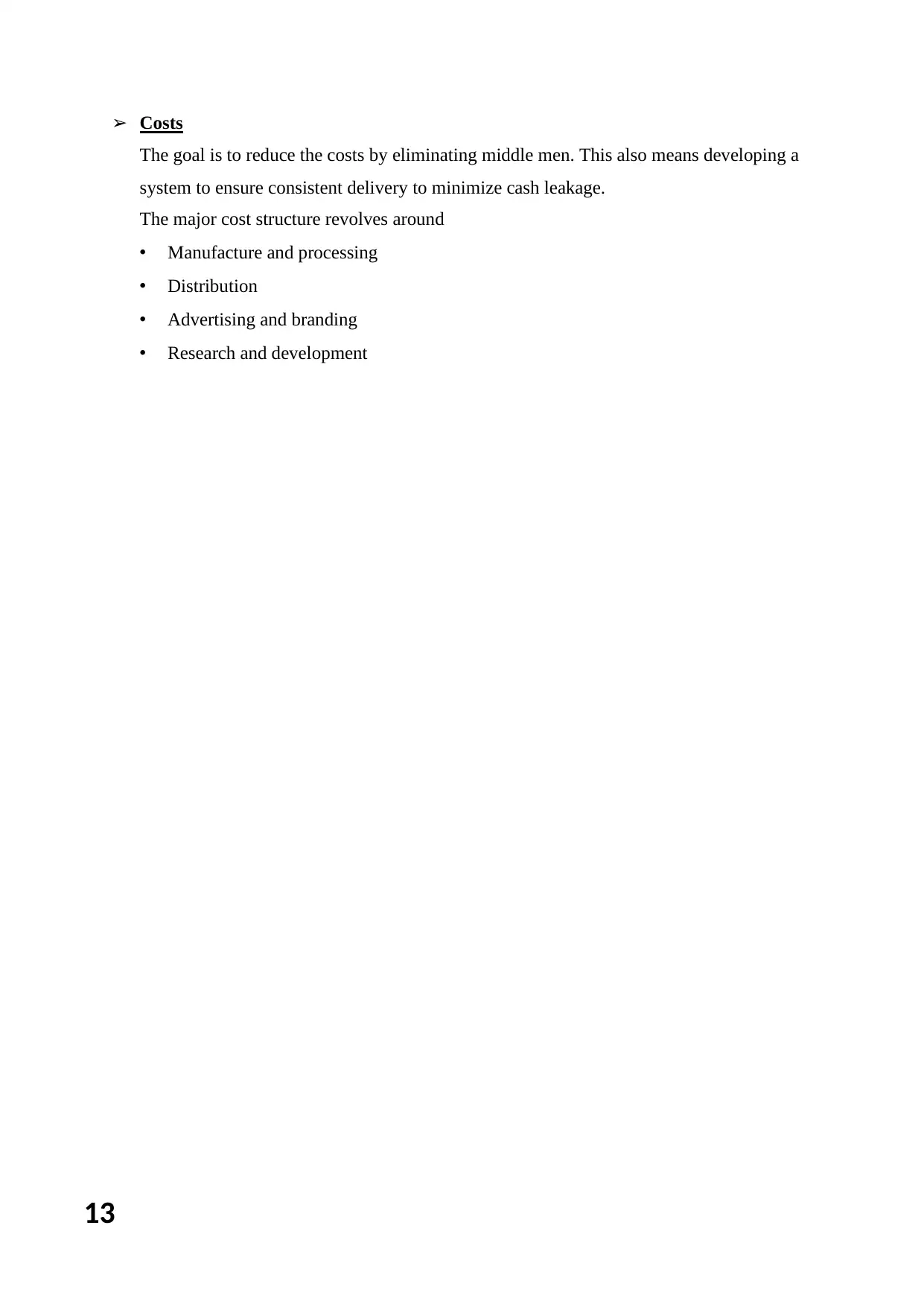
13
➢ Costs
The goal is to reduce the costs by eliminating middle men. This also means developing a
system to ensure consistent delivery to minimize cash leakage.
The major cost structure revolves around
• Manufacture and processing
• Distribution
• Advertising and branding
• Research and development
➢ Costs
The goal is to reduce the costs by eliminating middle men. This also means developing a
system to ensure consistent delivery to minimize cash leakage.
The major cost structure revolves around
• Manufacture and processing
• Distribution
• Advertising and branding
• Research and development
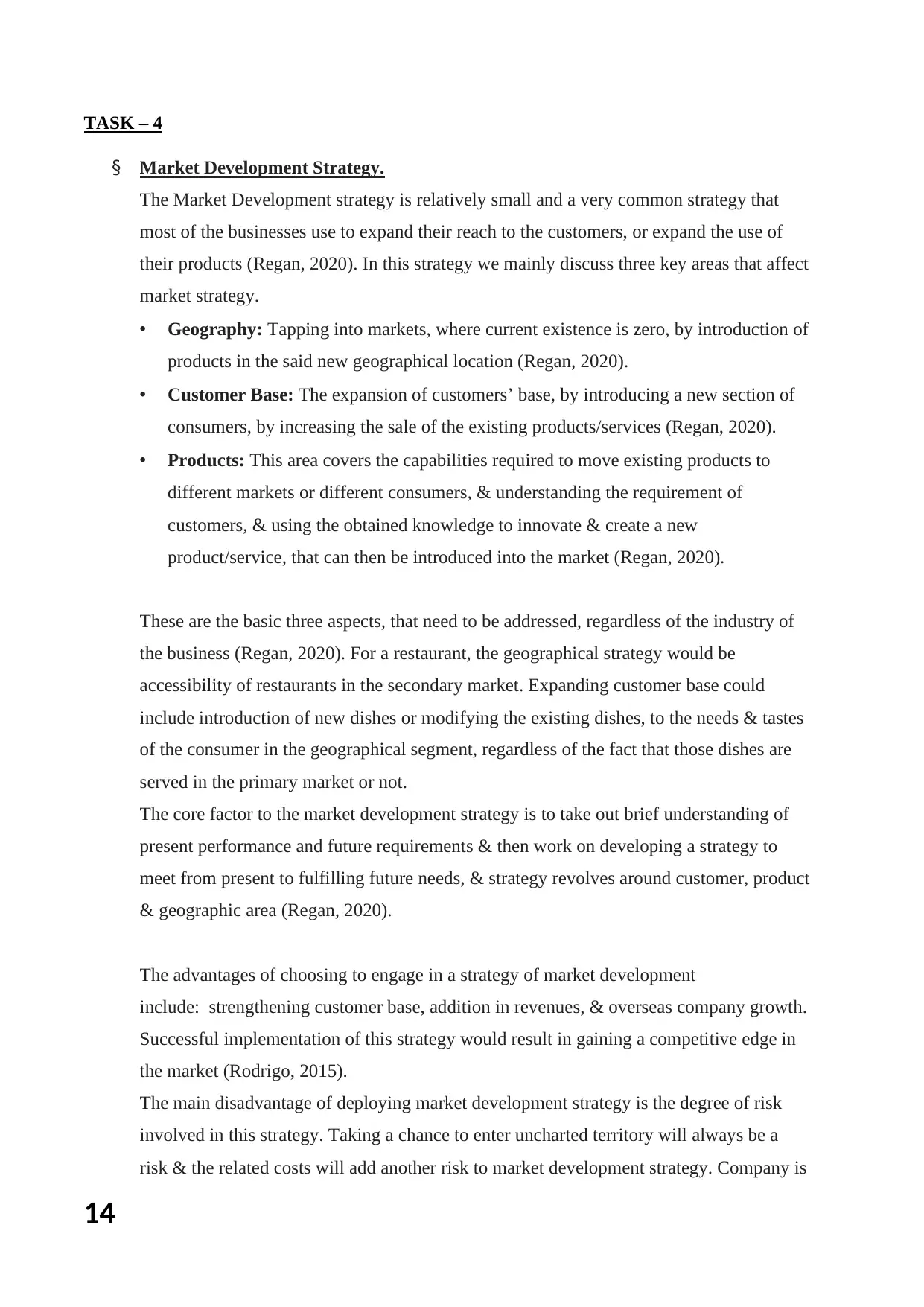
14
TASK – 4
§ Market Development Strategy.
The Market Development strategy is relatively small and a very common strategy that
most of the businesses use to expand their reach to the customers, or expand the use of
their products (Regan, 2020). In this strategy we mainly discuss three key areas that affect
market strategy.
• Geography: Tapping into markets, where current existence is zero, by introduction of
products in the said new geographical location (Regan, 2020).
• Customer Base: The expansion of customers’ base, by introducing a new section of
consumers, by increasing the sale of the existing products/services (Regan, 2020).
• Products: This area covers the capabilities required to move existing products to
different markets or different consumers, & understanding the requirement of
customers, & using the obtained knowledge to innovate & create a new
product/service, that can then be introduced into the market (Regan, 2020).
These are the basic three aspects, that need to be addressed, regardless of the industry of
the business (Regan, 2020). For a restaurant, the geographical strategy would be
accessibility of restaurants in the secondary market. Expanding customer base could
include introduction of new dishes or modifying the existing dishes, to the needs & tastes
of the consumer in the geographical segment, regardless of the fact that those dishes are
served in the primary market or not.
The core factor to the market development strategy is to take out brief understanding of
present performance and future requirements & then work on developing a strategy to
meet from present to fulfilling future needs, & strategy revolves around customer, product
& geographic area (Regan, 2020).
The advantages of choosing to engage in a strategy of market development
include: strengthening customer base, addition in revenues, & overseas company growth.
Successful implementation of this strategy would result in gaining a competitive edge in
the market (Rodrigo, 2015).
The main disadvantage of deploying market development strategy is the degree of risk
involved in this strategy. Taking a chance to enter uncharted territory will always be a
risk & the related costs will add another risk to market development strategy. Company is
TASK – 4
§ Market Development Strategy.
The Market Development strategy is relatively small and a very common strategy that
most of the businesses use to expand their reach to the customers, or expand the use of
their products (Regan, 2020). In this strategy we mainly discuss three key areas that affect
market strategy.
• Geography: Tapping into markets, where current existence is zero, by introduction of
products in the said new geographical location (Regan, 2020).
• Customer Base: The expansion of customers’ base, by introducing a new section of
consumers, by increasing the sale of the existing products/services (Regan, 2020).
• Products: This area covers the capabilities required to move existing products to
different markets or different consumers, & understanding the requirement of
customers, & using the obtained knowledge to innovate & create a new
product/service, that can then be introduced into the market (Regan, 2020).
These are the basic three aspects, that need to be addressed, regardless of the industry of
the business (Regan, 2020). For a restaurant, the geographical strategy would be
accessibility of restaurants in the secondary market. Expanding customer base could
include introduction of new dishes or modifying the existing dishes, to the needs & tastes
of the consumer in the geographical segment, regardless of the fact that those dishes are
served in the primary market or not.
The core factor to the market development strategy is to take out brief understanding of
present performance and future requirements & then work on developing a strategy to
meet from present to fulfilling future needs, & strategy revolves around customer, product
& geographic area (Regan, 2020).
The advantages of choosing to engage in a strategy of market development
include: strengthening customer base, addition in revenues, & overseas company growth.
Successful implementation of this strategy would result in gaining a competitive edge in
the market (Rodrigo, 2015).
The main disadvantage of deploying market development strategy is the degree of risk
involved in this strategy. Taking a chance to enter uncharted territory will always be a
risk & the related costs will add another risk to market development strategy. Company is
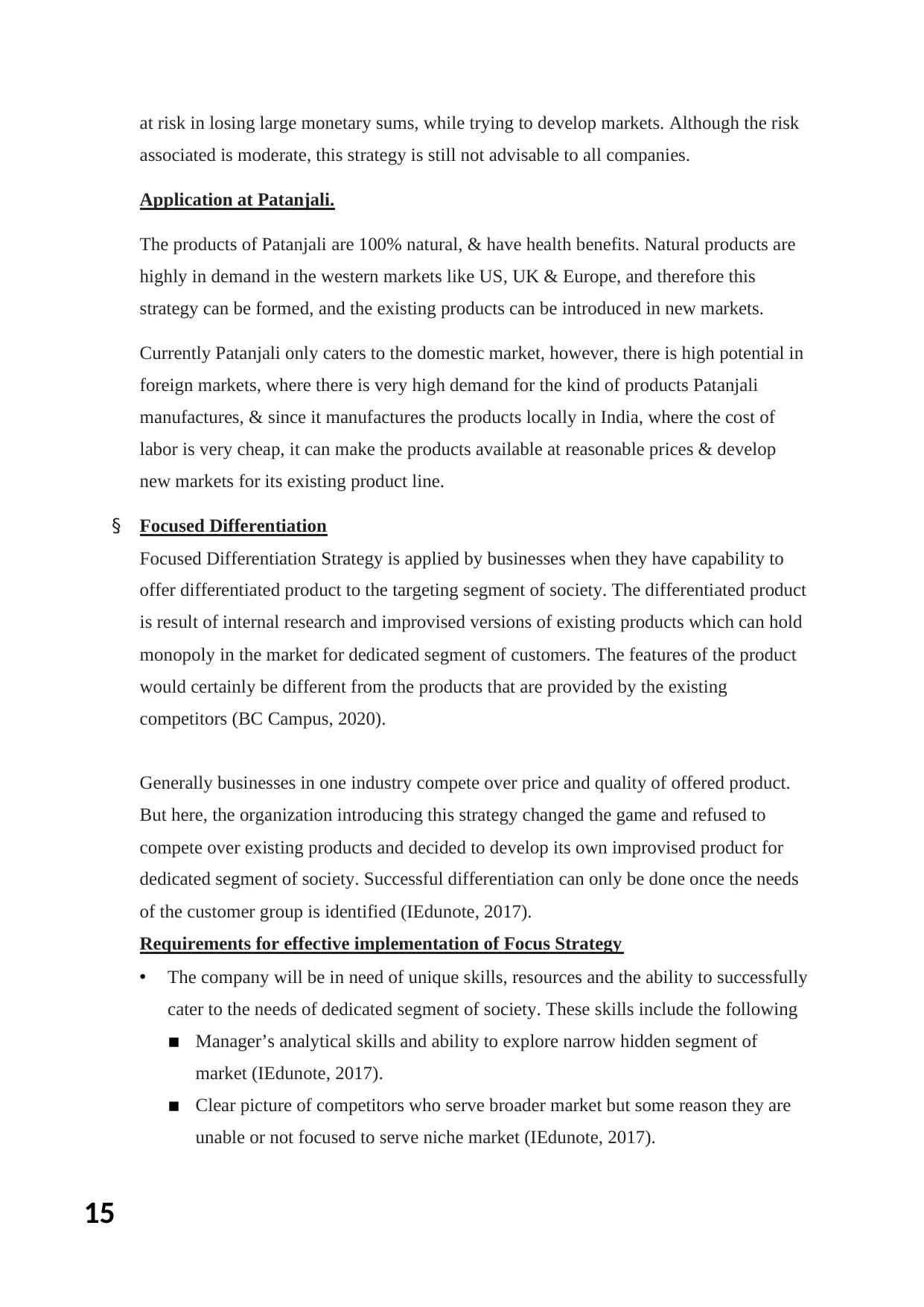
15
at risk in losing large monetary sums, while trying to develop markets. Although the risk
associated is moderate, this strategy is still not advisable to all companies.
Application at Patanjali.
The products of Patanjali are 100% natural, & have health benefits. Natural products are
highly in demand in the western markets like US, UK & Europe, and therefore this
strategy can be formed, and the existing products can be introduced in new markets.
Currently Patanjali only caters to the domestic market, however, there is high potential in
foreign markets, where there is very high demand for the kind of products Patanjali
manufactures, & since it manufactures the products locally in India, where the cost of
labor is very cheap, it can make the products available at reasonable prices & develop
new markets for its existing product line.
§ Focused Differentiation
Focused Differentiation Strategy is applied by businesses when they have capability to
offer differentiated product to the targeting segment of society. The differentiated product
is result of internal research and improvised versions of existing products which can hold
monopoly in the market for dedicated segment of customers. The features of the product
would certainly be different from the products that are provided by the existing
competitors (BC Campus, 2020).
Generally businesses in one industry compete over price and quality of offered product.
But here, the organization introducing this strategy changed the game and refused to
compete over existing products and decided to develop its own improvised product for
dedicated segment of society. Successful differentiation can only be done once the needs
of the customer group is identified (IEdunote, 2017).
Requirements for effective implementation of Focus Strategy
• The company will be in need of unique skills, resources and the ability to successfully
cater to the needs of dedicated segment of society. These skills include the following
▪ Manager’s analytical skills and ability to explore narrow hidden segment of
market (IEdunote, 2017).
▪ Clear picture of competitors who serve broader market but some reason they are
unable or not focused to serve niche market (IEdunote, 2017).
at risk in losing large monetary sums, while trying to develop markets. Although the risk
associated is moderate, this strategy is still not advisable to all companies.
Application at Patanjali.
The products of Patanjali are 100% natural, & have health benefits. Natural products are
highly in demand in the western markets like US, UK & Europe, and therefore this
strategy can be formed, and the existing products can be introduced in new markets.
Currently Patanjali only caters to the domestic market, however, there is high potential in
foreign markets, where there is very high demand for the kind of products Patanjali
manufactures, & since it manufactures the products locally in India, where the cost of
labor is very cheap, it can make the products available at reasonable prices & develop
new markets for its existing product line.
§ Focused Differentiation
Focused Differentiation Strategy is applied by businesses when they have capability to
offer differentiated product to the targeting segment of society. The differentiated product
is result of internal research and improvised versions of existing products which can hold
monopoly in the market for dedicated segment of customers. The features of the product
would certainly be different from the products that are provided by the existing
competitors (BC Campus, 2020).
Generally businesses in one industry compete over price and quality of offered product.
But here, the organization introducing this strategy changed the game and refused to
compete over existing products and decided to develop its own improvised product for
dedicated segment of society. Successful differentiation can only be done once the needs
of the customer group is identified (IEdunote, 2017).
Requirements for effective implementation of Focus Strategy
• The company will be in need of unique skills, resources and the ability to successfully
cater to the needs of dedicated segment of society. These skills include the following
▪ Manager’s analytical skills and ability to explore narrow hidden segment of
market (IEdunote, 2017).
▪ Clear picture of competitors who serve broader market but some reason they are
unable or not focused to serve niche market (IEdunote, 2017).
Secure Best Marks with AI Grader
Need help grading? Try our AI Grader for instant feedback on your assignments.

16
▪ Company's financial capability to put additional capital for niche market
(IEdunote, 2017).
▪ Defining and maintaining a cost effective distribution channel and cooperation
with channel members (IEdunote, 2017).
▪ Determined marketing personnel with creative skill set (IEdunote, 2017).
Situations in the market that favor the implementation of this strategy.
A focus strategy is not suitable for general market conditions. Managers find it attractive
in the following situations.
• Consumers’ distinctive preferences: Focused strategy work effectively where
organizations have discovered different needs and preferences of customer & their
needs have remained unfulfilled by competitors (IEdunote, 2017).
• Competitors’ apathy: If competitors have decided to not get involve in the niche
market, the greater chance of success the strategy will have (IEdunote, 2017).
• Profitable niche: The focus strategy is mostly implemented where target niche
segment is big enough to bring them profitable results. A small niche is not profitable
at cost of new investment (IEdunote, 2017).
• High growth potential: Niche market become attractive to businesses
owners/Managers where scope of growth is there in niche market. If businesses find
potential growth in niche market then they would be ready to explore and invest
(IEdunote, 2017).
• Availability of different niches in the industry: It could happen that single industry
has different niche market and choice of niche market is available, wherein the most
attractive can be selected (IEdunote, 2017).
• Competitor may be unwilling to cater to the niche market: The competitors who
has hold in wide market area would find it to be difficult to focus on specialized small
segments of market. Several factors could be there, which pull competitor behind
(IEdunote, 2017).
▪ Company's financial capability to put additional capital for niche market
(IEdunote, 2017).
▪ Defining and maintaining a cost effective distribution channel and cooperation
with channel members (IEdunote, 2017).
▪ Determined marketing personnel with creative skill set (IEdunote, 2017).
Situations in the market that favor the implementation of this strategy.
A focus strategy is not suitable for general market conditions. Managers find it attractive
in the following situations.
• Consumers’ distinctive preferences: Focused strategy work effectively where
organizations have discovered different needs and preferences of customer & their
needs have remained unfulfilled by competitors (IEdunote, 2017).
• Competitors’ apathy: If competitors have decided to not get involve in the niche
market, the greater chance of success the strategy will have (IEdunote, 2017).
• Profitable niche: The focus strategy is mostly implemented where target niche
segment is big enough to bring them profitable results. A small niche is not profitable
at cost of new investment (IEdunote, 2017).
• High growth potential: Niche market become attractive to businesses
owners/Managers where scope of growth is there in niche market. If businesses find
potential growth in niche market then they would be ready to explore and invest
(IEdunote, 2017).
• Availability of different niches in the industry: It could happen that single industry
has different niche market and choice of niche market is available, wherein the most
attractive can be selected (IEdunote, 2017).
• Competitor may be unwilling to cater to the niche market: The competitors who
has hold in wide market area would find it to be difficult to focus on specialized small
segments of market. Several factors could be there, which pull competitor behind
(IEdunote, 2017).
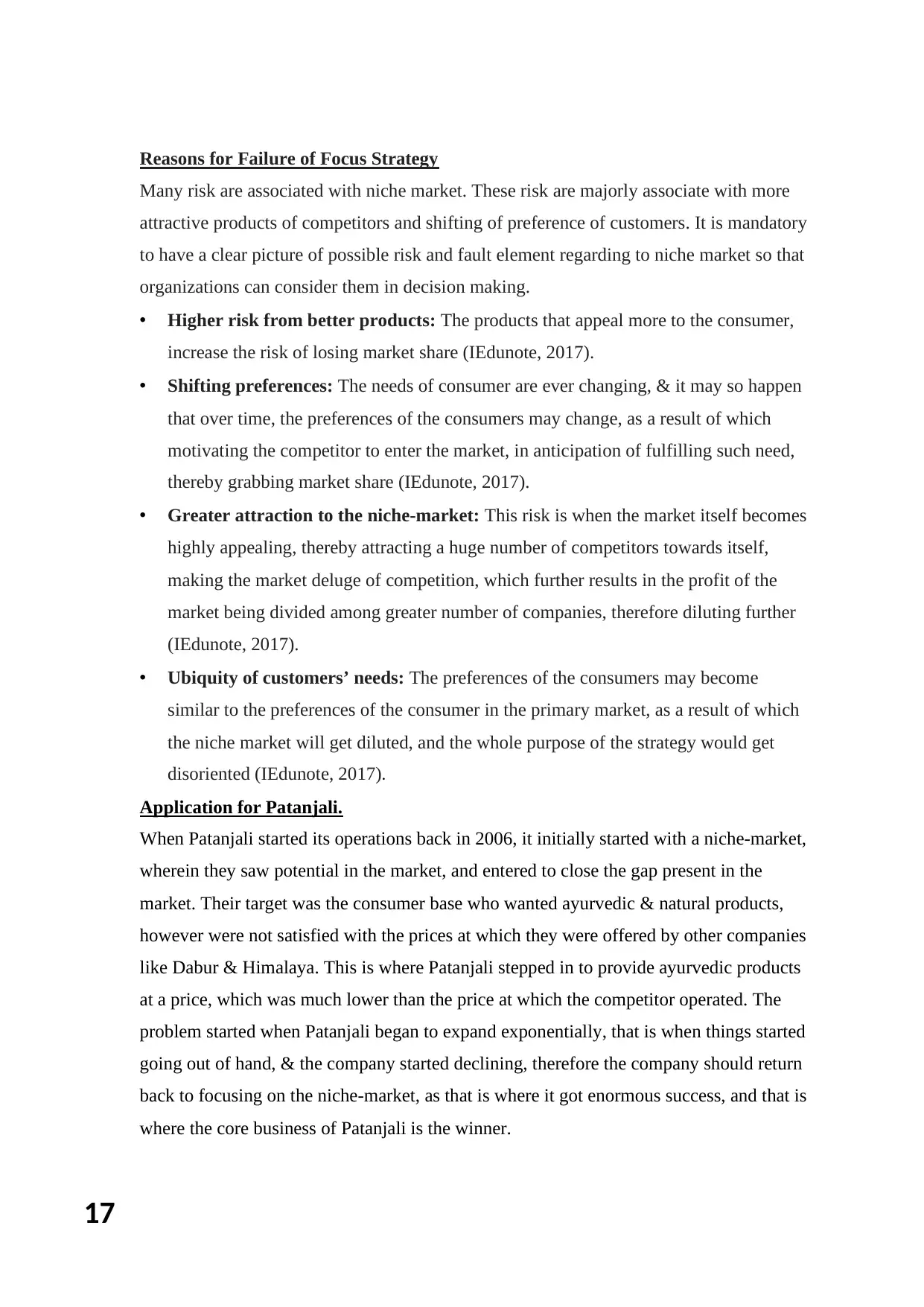
17
Reasons for Failure of Focus Strategy
Many risk are associated with niche market. These risk are majorly associate with more
attractive products of competitors and shifting of preference of customers. It is mandatory
to have a clear picture of possible risk and fault element regarding to niche market so that
organizations can consider them in decision making.
• Higher risk from better products: The products that appeal more to the consumer,
increase the risk of losing market share (IEdunote, 2017).
• Shifting preferences: The needs of consumer are ever changing, & it may so happen
that over time, the preferences of the consumers may change, as a result of which
motivating the competitor to enter the market, in anticipation of fulfilling such need,
thereby grabbing market share (IEdunote, 2017).
• Greater attraction to the niche-market: This risk is when the market itself becomes
highly appealing, thereby attracting a huge number of competitors towards itself,
making the market deluge of competition, which further results in the profit of the
market being divided among greater number of companies, therefore diluting further
(IEdunote, 2017).
• Ubiquity of customers’ needs: The preferences of the consumers may become
similar to the preferences of the consumer in the primary market, as a result of which
the niche market will get diluted, and the whole purpose of the strategy would get
disoriented (IEdunote, 2017).
Application for Patanjali.
When Patanjali started its operations back in 2006, it initially started with a niche-market,
wherein they saw potential in the market, and entered to close the gap present in the
market. Their target was the consumer base who wanted ayurvedic & natural products,
however were not satisfied with the prices at which they were offered by other companies
like Dabur & Himalaya. This is where Patanjali stepped in to provide ayurvedic products
at a price, which was much lower than the price at which the competitor operated. The
problem started when Patanjali began to expand exponentially, that is when things started
going out of hand, & the company started declining, therefore the company should return
back to focusing on the niche-market, as that is where it got enormous success, and that is
where the core business of Patanjali is the winner.
Reasons for Failure of Focus Strategy
Many risk are associated with niche market. These risk are majorly associate with more
attractive products of competitors and shifting of preference of customers. It is mandatory
to have a clear picture of possible risk and fault element regarding to niche market so that
organizations can consider them in decision making.
• Higher risk from better products: The products that appeal more to the consumer,
increase the risk of losing market share (IEdunote, 2017).
• Shifting preferences: The needs of consumer are ever changing, & it may so happen
that over time, the preferences of the consumers may change, as a result of which
motivating the competitor to enter the market, in anticipation of fulfilling such need,
thereby grabbing market share (IEdunote, 2017).
• Greater attraction to the niche-market: This risk is when the market itself becomes
highly appealing, thereby attracting a huge number of competitors towards itself,
making the market deluge of competition, which further results in the profit of the
market being divided among greater number of companies, therefore diluting further
(IEdunote, 2017).
• Ubiquity of customers’ needs: The preferences of the consumers may become
similar to the preferences of the consumer in the primary market, as a result of which
the niche market will get diluted, and the whole purpose of the strategy would get
disoriented (IEdunote, 2017).
Application for Patanjali.
When Patanjali started its operations back in 2006, it initially started with a niche-market,
wherein they saw potential in the market, and entered to close the gap present in the
market. Their target was the consumer base who wanted ayurvedic & natural products,
however were not satisfied with the prices at which they were offered by other companies
like Dabur & Himalaya. This is where Patanjali stepped in to provide ayurvedic products
at a price, which was much lower than the price at which the competitor operated. The
problem started when Patanjali began to expand exponentially, that is when things started
going out of hand, & the company started declining, therefore the company should return
back to focusing on the niche-market, as that is where it got enormous success, and that is
where the core business of Patanjali is the winner.

18
TASK – 5
FINAL CONCLUSION.
For implementing any business strategy dedicated task plan should be developed that
needs to be performed, which ultimately helps in achieving strategic goals. For every
task, list of required resources should be in place and should be discussed with each level
managers. Managers check the availability of resources in house or whether they need to
bring resources from the market. Resources are the key which unlocks strategic goals. In
the case of Patanjali, the market development strategy & focused differentiation strategy
has been discussed above. In light of the above strategies, the following conclusions can
be drawn, that would guide the organization in implementing the strategies & achieving
organization goal.
Following are the resource implications for Patanjali.
Agricultural Land: Since Patanjali deals in herbal products, which are made of different
variety of herbs/plants., which need to be grown in large quantities to be further
consumed in the commercial production of plant based products, large pieces of
agricultural land would be required for growing and for cultivation of herbs/plants. It is
an advantage for production set up in India where climate is in favor of agricultural
activity.
Labor: Manpower is required for every business activity. Skilled and unskilled labor is
required for having business to grow. Skilled labor is required for Patanjali's
manufacturing units and unskilled labor is required for agricultural activities.
Technology: Product manufacturing is done by using blend of variety of resources one of
which is technology. Looking at the market reach and differentiated product
manufacturing. Use of upgraded technology is required to meet international
manufacturing standards and competitive advantage in home country. For example new
scientific nanotechnology should be used in manufacturing health care products.
Investment: There is need of capital at every stage of manufacturing product. For making
use of above resources in production, investment would be required. For example capital
investment would be required for purchasing land, labor and infrastructure.
Distribution channel: To reach overseas market and customers in home country there
would be a need of strong distribution channel partnership with transporters, distributors
and government to make product distribution path smooth. If product distribution path is
not effective or in favor then there arises chances of deteriorating customer relationship.
TASK – 5
FINAL CONCLUSION.
For implementing any business strategy dedicated task plan should be developed that
needs to be performed, which ultimately helps in achieving strategic goals. For every
task, list of required resources should be in place and should be discussed with each level
managers. Managers check the availability of resources in house or whether they need to
bring resources from the market. Resources are the key which unlocks strategic goals. In
the case of Patanjali, the market development strategy & focused differentiation strategy
has been discussed above. In light of the above strategies, the following conclusions can
be drawn, that would guide the organization in implementing the strategies & achieving
organization goal.
Following are the resource implications for Patanjali.
Agricultural Land: Since Patanjali deals in herbal products, which are made of different
variety of herbs/plants., which need to be grown in large quantities to be further
consumed in the commercial production of plant based products, large pieces of
agricultural land would be required for growing and for cultivation of herbs/plants. It is
an advantage for production set up in India where climate is in favor of agricultural
activity.
Labor: Manpower is required for every business activity. Skilled and unskilled labor is
required for having business to grow. Skilled labor is required for Patanjali's
manufacturing units and unskilled labor is required for agricultural activities.
Technology: Product manufacturing is done by using blend of variety of resources one of
which is technology. Looking at the market reach and differentiated product
manufacturing. Use of upgraded technology is required to meet international
manufacturing standards and competitive advantage in home country. For example new
scientific nanotechnology should be used in manufacturing health care products.
Investment: There is need of capital at every stage of manufacturing product. For making
use of above resources in production, investment would be required. For example capital
investment would be required for purchasing land, labor and infrastructure.
Distribution channel: To reach overseas market and customers in home country there
would be a need of strong distribution channel partnership with transporters, distributors
and government to make product distribution path smooth. If product distribution path is
not effective or in favor then there arises chances of deteriorating customer relationship.
Paraphrase This Document
Need a fresh take? Get an instant paraphrase of this document with our AI Paraphraser
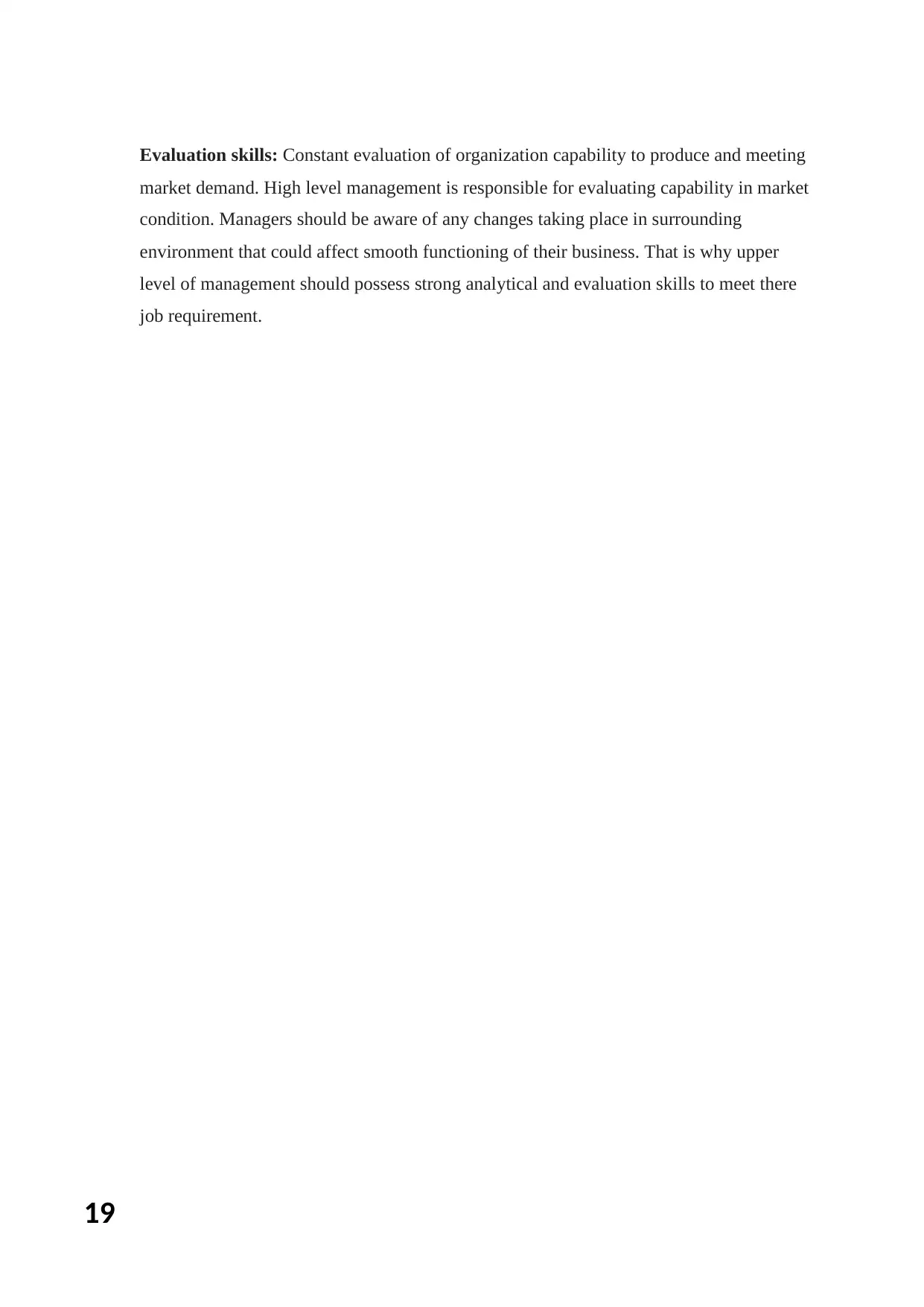
19
Evaluation skills: Constant evaluation of organization capability to produce and meeting
market demand. High level management is responsible for evaluating capability in market
condition. Managers should be aware of any changes taking place in surrounding
environment that could affect smooth functioning of their business. That is why upper
level of management should possess strong analytical and evaluation skills to meet there
job requirement.
Evaluation skills: Constant evaluation of organization capability to produce and meeting
market demand. High level management is responsible for evaluating capability in market
condition. Managers should be aware of any changes taking place in surrounding
environment that could affect smooth functioning of their business. That is why upper
level of management should possess strong analytical and evaluation skills to meet there
job requirement.

20
References
Balachandran, M., 2017. How Patanjali prices itself against rivals. [Online]
Available at: https://theatlas.com/charts/EJn1wLFYx
[Accessed 18 July 2020].
BC Campus, 2020. Focused Cost Leadership and Focused Differentiation. [Online]
Available at: https://opentextbc.ca/strategicmanagement/chapter/focused-cost-leadership-and-
focused-differentiation/
[Accessed 21 July 2020].
Bhasin, H., 2020. Marketing 91. [Online]
Available at: https://www.marketing91.com/business-model-of-patanjali/
[Accessed 23 July 2020].
Business to You, 2016. Scanning the Environment: PESTEL Analysis. [Online]
Available at: https://www.business-to-you.com/scanning-the-environment-pestel-analysis/
[Accessed 17 July 2020].
CGMA, 2013. Porter’s Five Forces of Competitive Position Analysis. [Online]
Available at: https://www.cgma.org/resources/tools/essential-tools/porters-five-forces.html
[Accessed 18 July 2020].
Gasteren, W. V., 2020. Growth Hacking: What is it & How can Growth Marketing help you?. [Online]
Available at: https://growwithward.com/what-is-growth-hacking/
[Accessed 15 July 2020].
Gupta, P., Himan, D. & Ramadoss, V., 2016. The secret behind Patanjali’s rise and rise. [Online]
Available at: https://www.thehindubusinessline.com/catalyst/the-secret-behind-patanjalis-rise-and-
rise/article9300591.ece#
[Accessed 16 July 2020].
Hindustan Times, 2017. Politics and religion: As BJP government rises, so does yoga tycoon Baba
Ramdev. [Online]
Available at: https://www.hindustantimes.com/india-news/politics-and-religion-as-bjp-government-
rises-so-does-yoga-tycoon-baba-ramdev/story-v5k2qSB8CA83kD2IGh4yHP.html
[Accessed 17 July 2020].
Hopkins, B., 2018. Patanjali takes on Industry Giants. [Online]
Available at: https://www.case48.com/porter-case/12785-Patanjali-Takes-On-Industry-Giants
[Accessed 18 July 2020].
IEdunote, 2017. Focus Strategy: Meaning, Types of Focus Strategy. [Online]
Available at: https://www.iedunote.com/focus-strategy
[Accessed 21 July 2020].
India Brand Equity Foundation, n.d. About Us: India Brand Equity Foundation (IBEF). [Online]
Available at: https://www.ibef.org/industry/fmcg/showcase/patanjali-ayurved-limited
[Accessed 23 July 2020].
References
Balachandran, M., 2017. How Patanjali prices itself against rivals. [Online]
Available at: https://theatlas.com/charts/EJn1wLFYx
[Accessed 18 July 2020].
BC Campus, 2020. Focused Cost Leadership and Focused Differentiation. [Online]
Available at: https://opentextbc.ca/strategicmanagement/chapter/focused-cost-leadership-and-
focused-differentiation/
[Accessed 21 July 2020].
Bhasin, H., 2020. Marketing 91. [Online]
Available at: https://www.marketing91.com/business-model-of-patanjali/
[Accessed 23 July 2020].
Business to You, 2016. Scanning the Environment: PESTEL Analysis. [Online]
Available at: https://www.business-to-you.com/scanning-the-environment-pestel-analysis/
[Accessed 17 July 2020].
CGMA, 2013. Porter’s Five Forces of Competitive Position Analysis. [Online]
Available at: https://www.cgma.org/resources/tools/essential-tools/porters-five-forces.html
[Accessed 18 July 2020].
Gasteren, W. V., 2020. Growth Hacking: What is it & How can Growth Marketing help you?. [Online]
Available at: https://growwithward.com/what-is-growth-hacking/
[Accessed 15 July 2020].
Gupta, P., Himan, D. & Ramadoss, V., 2016. The secret behind Patanjali’s rise and rise. [Online]
Available at: https://www.thehindubusinessline.com/catalyst/the-secret-behind-patanjalis-rise-and-
rise/article9300591.ece#
[Accessed 16 July 2020].
Hindustan Times, 2017. Politics and religion: As BJP government rises, so does yoga tycoon Baba
Ramdev. [Online]
Available at: https://www.hindustantimes.com/india-news/politics-and-religion-as-bjp-government-
rises-so-does-yoga-tycoon-baba-ramdev/story-v5k2qSB8CA83kD2IGh4yHP.html
[Accessed 17 July 2020].
Hopkins, B., 2018. Patanjali takes on Industry Giants. [Online]
Available at: https://www.case48.com/porter-case/12785-Patanjali-Takes-On-Industry-Giants
[Accessed 18 July 2020].
IEdunote, 2017. Focus Strategy: Meaning, Types of Focus Strategy. [Online]
Available at: https://www.iedunote.com/focus-strategy
[Accessed 21 July 2020].
India Brand Equity Foundation, n.d. About Us: India Brand Equity Foundation (IBEF). [Online]
Available at: https://www.ibef.org/industry/fmcg/showcase/patanjali-ayurved-limited
[Accessed 23 July 2020].
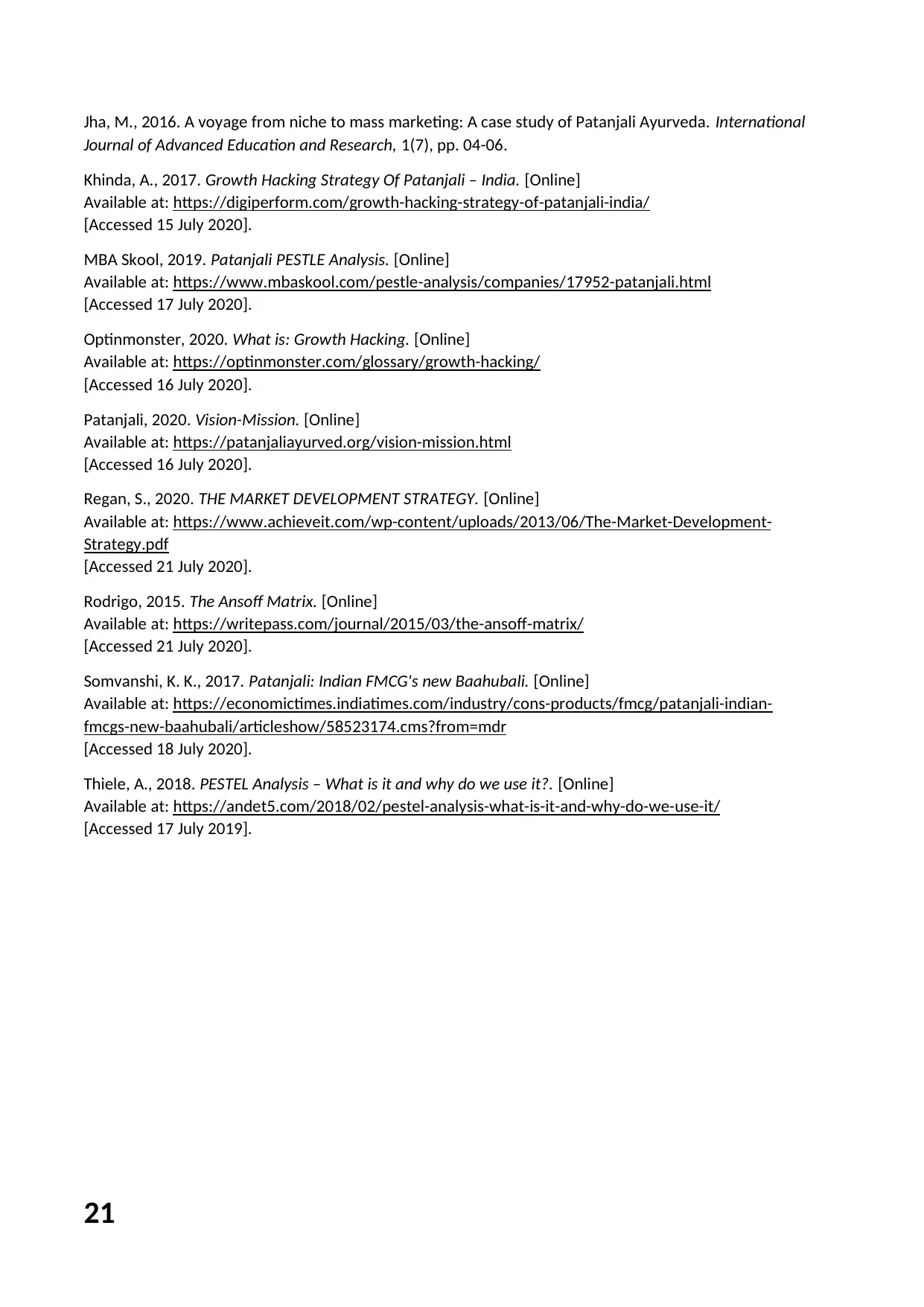
21
Jha, M., 2016. A voyage from niche to mass marketing: A case study of Patanjali Ayurveda. International
Journal of Advanced Education and Research, 1(7), pp. 04-06.
Khinda, A., 2017. Growth Hacking Strategy Of Patanjali – India. [Online]
Available at: https://digiperform.com/growth-hacking-strategy-of-patanjali-india/
[Accessed 15 July 2020].
MBA Skool, 2019. Patanjali PESTLE Analysis. [Online]
Available at: https://www.mbaskool.com/pestle-analysis/companies/17952-patanjali.html
[Accessed 17 July 2020].
Optinmonster, 2020. What is: Growth Hacking. [Online]
Available at: https://optinmonster.com/glossary/growth-hacking/
[Accessed 16 July 2020].
Patanjali, 2020. Vision-Mission. [Online]
Available at: https://patanjaliayurved.org/vision-mission.html
[Accessed 16 July 2020].
Regan, S., 2020. THE MARKET DEVELOPMENT STRATEGY. [Online]
Available at: https://www.achieveit.com/wp-content/uploads/2013/06/The-Market-Development-
Strategy.pdf
[Accessed 21 July 2020].
Rodrigo, 2015. The Ansoff Matrix. [Online]
Available at: https://writepass.com/journal/2015/03/the-ansoff-matrix/
[Accessed 21 July 2020].
Somvanshi, K. K., 2017. Patanjali: Indian FMCG's new Baahubali. [Online]
Available at: https://economictimes.indiatimes.com/industry/cons-products/fmcg/patanjali-indian-
fmcgs-new-baahubali/articleshow/58523174.cms?from=mdr
[Accessed 18 July 2020].
Thiele, A., 2018. PESTEL Analysis – What is it and why do we use it?. [Online]
Available at: https://andet5.com/2018/02/pestel-analysis-what-is-it-and-why-do-we-use-it/
[Accessed 17 July 2019].
Jha, M., 2016. A voyage from niche to mass marketing: A case study of Patanjali Ayurveda. International
Journal of Advanced Education and Research, 1(7), pp. 04-06.
Khinda, A., 2017. Growth Hacking Strategy Of Patanjali – India. [Online]
Available at: https://digiperform.com/growth-hacking-strategy-of-patanjali-india/
[Accessed 15 July 2020].
MBA Skool, 2019. Patanjali PESTLE Analysis. [Online]
Available at: https://www.mbaskool.com/pestle-analysis/companies/17952-patanjali.html
[Accessed 17 July 2020].
Optinmonster, 2020. What is: Growth Hacking. [Online]
Available at: https://optinmonster.com/glossary/growth-hacking/
[Accessed 16 July 2020].
Patanjali, 2020. Vision-Mission. [Online]
Available at: https://patanjaliayurved.org/vision-mission.html
[Accessed 16 July 2020].
Regan, S., 2020. THE MARKET DEVELOPMENT STRATEGY. [Online]
Available at: https://www.achieveit.com/wp-content/uploads/2013/06/The-Market-Development-
Strategy.pdf
[Accessed 21 July 2020].
Rodrigo, 2015. The Ansoff Matrix. [Online]
Available at: https://writepass.com/journal/2015/03/the-ansoff-matrix/
[Accessed 21 July 2020].
Somvanshi, K. K., 2017. Patanjali: Indian FMCG's new Baahubali. [Online]
Available at: https://economictimes.indiatimes.com/industry/cons-products/fmcg/patanjali-indian-
fmcgs-new-baahubali/articleshow/58523174.cms?from=mdr
[Accessed 18 July 2020].
Thiele, A., 2018. PESTEL Analysis – What is it and why do we use it?. [Online]
Available at: https://andet5.com/2018/02/pestel-analysis-what-is-it-and-why-do-we-use-it/
[Accessed 17 July 2019].
1 out of 22
Your All-in-One AI-Powered Toolkit for Academic Success.
+13062052269
info@desklib.com
Available 24*7 on WhatsApp / Email
![[object Object]](/_next/static/media/star-bottom.7253800d.svg)
Unlock your academic potential
© 2024 | Zucol Services PVT LTD | All rights reserved.